23 December 2021. Small swarms form in NE Somalia
OVERVIEW. As late instar hopper bands continue to fledge, more new small immature swarms are forming in northeast Somalia where aerial and ground control operations are in progress north of Garowe. Limited aerial control operations continue against a few small immature and mature swarms that persist in the Rift Valley of SNNP near the Kenya border. Low numbers of solitarious locusts are present in winter breeding areas along both sides of the Red Sea and on the Gulf of Aden coast of northwest Somalia, and limited breeding has started in a few places.
WHY IT MATTERS. The current success of control operations in northeast Somalia is limiting the number and size of immature swarms that will form in the next two weeks. By the end of this month, nearly all hopper bands will have fledged. Consequently, a few more small swarms will form. So far, the new swarms have not moved much from the breeding areas; however, this will change as they become stronger and vegetation dries out, giving rise to a southwards migration that passes over central Somalia and eastern Ethiopia to reach southeast Ethiopia, northeast Kenya, and southern Somalia at any time in the coming week. Upon arrival, the swarms should continue further west in Wajir, Marsabit, Samburu, and Turkana counties of Kenya and southern parts of Oromia and SNNP regions in Ethiopia. The threat of swarm arrival in these areas should subside by mid-January. It will take at least one month for the swarms to mature and be ready to lay eggs. By that time, however, conditions in southern Ethiopia and northern Kenya are unlikely to be favourable since it will be the dry season. Consequently, the swarms may remain immature until the long rains arrive in April/May, which would allow maturation and egg-laying. Given this scenario, field teams are expected to have the necessary resources, experience, and time to control the swarms before April and bring the current upsurge to an end.
CONTEXT. New swarms form in northeast Somalia but have yet to start migrating southwards.
• SOMALIA. Control operations continue against small late instar hopper bands and newly formed immature swarms in the NE; scattered adults in the northwest with limited breeding.
• ETHIOPIA. Control continues against a few small swarms that persist in the Rift Valley of southern SNNP near the Kenya border.
• KENYA. No locusts seen, but limited breeding could be underway along the northern border.
• RED SEA. Scattered adults on the coast of Yemen, Sudan, and SE Egypt while limited breeding started in Egypt and Yemen; no locusts on the coast of Saudi Arabia and Eritrea.
TAKEAWAY. Maintain current efforts to reduce swarm formation in the Horn of Africa.
• Central Region (SERIOUS) – maintain operations (Ethiopia, Somalia); increase vigilance (N. Kenya)
• Western Region (CALM) – no significant activities
• Eastern Region (CALM) – no significant activities
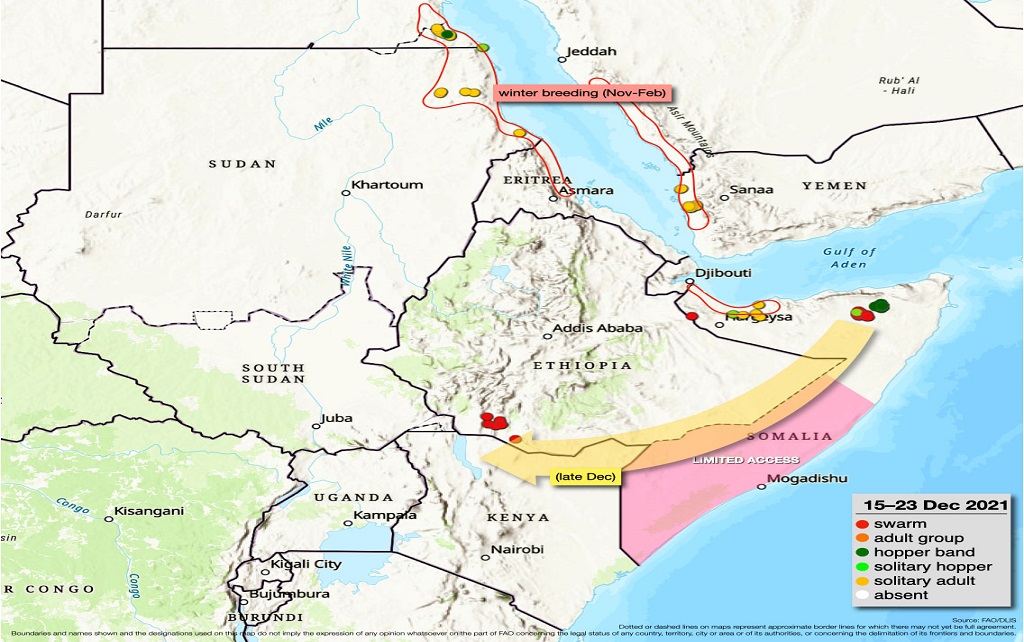
Situation and forecast.
14 December 2021. Fledging starts in NE Somalia
OVERVIEW. The fledging of hoppers into immature adults commenced today in northeast Somalia where aerial and ground control operations continue against late instar hopper bands. The operations have been extremely effective in reducing the infestations and delaying fledging by at least one week. In southern Ethiopia, limited aerial control operations continue against a couple of small mature swarms that persist in the Rift Valley of SNNP near the Kenya border. Low numbers of solitarious locusts are present in winter breeding areas along both sides of the Red Sea.
WHY IT MATTERS. The current success of control operations in northeast Somalia has undoubtedly limited the number and size of immature swarms that will form in the next two weeks. Nevertheless, a few small swarms from undetected and untreated areas should start to form in the coming week given current temperatures. Since vegetation is drying out and the prevailing winds are from the northeast, the swarms are likely to migrate southwards, passing over central Somalia and eastern Ethiopia to reach southeast Ethiopia, northeast Kenya, and southern Somalia on about 24 December or thereafter. Upon arrival, the swarms should continue further west in Wajir, Marsabit, Samburu, and Turkana counties of Kenya and southern parts of Oromia and SNNP regions in Ethiopia. The threat of swarm arrival in these areas should subside by early January. It will take at least one month for the swarms to mature and be ready to lay eggs. By that time, however, conditions are not likely to be favourable since it will be the dry season. Consequently, the swarms may remain immature until the long rains arrive in April/May, which would allow maturation and egg-laying. Given this scenario, field teams are expected to have the necessary resources, experience, and time to control the swarms before April and bring the current upsurge to an end.
CONTEXT. Two hot spots, in Somali and Ethiopia, remain in the Horn of Africa.
• SOMALIA. Control operations continue against small late instar hopper bands in the NE where fledging started today, which will cause a few small immature swarms to form after about a week.
• ETHIOPIA. Control continues against a few small mature swarms that persist in the Rift Valley of southern SNNP near the Kenya border.
• KENYA. No locusts seen, but limited breeding could be underway along northern border.
• ERITREA. Scattered adults on the central Red Sea coast.
• YEMEN. Scattered adults on the Red Sea coast.
• SUDAN. Infestations declining in the interior; scattered adults on the Red Sea coast.
• EGYPT. Scattered adults on the Red Sea coast in the southeast.
• SAUDI ARABIA. No locusts on the southern coast of Red Sea but may arrive from nearby Yemen.
TAKEAWAY. Maintain current efforts to reduce swarm formation in the Horn of Africa.
• Central Region (SERIOUS) – maintain operations (Ethiopia, Somalia); increase vigilance (N. Kenya)
• Western Region (CALM) – no significant activities
• Eastern Region (CALM) – no significant activities

Situation and forecast.
2 December 2021. Kenya threat in mid-December
Although the current upsurge continues in the Horn of Africa on a much-reduced scale, two hot spots currently remain.
First, aerial and ground control operations continue in northeast Somalia against an increasing number of very small, but numerous hopper bands that formed during November. As some infestations will be missed and cannot be treated, a limited number of new small immature swarms will form from the second week of December onwards. As vegetation dries out, the swarms will migrate south to southern Ethiopia and southern Somalia where they could start to appear in northeast Kenya in mid-December and spread west across the northern counties. The scale of any swarm migration from northeast Somalia is likely to be limited, depending on the success of current survey and control operations.
Second, a few small spring-bred mature swarms from northeast Somalia arrived in northeast Kenya during the first week of November and then moved back into southern Ethiopia where control operations are in progress. These swarms are likely to lay eggs that will hatch, and small hopper bands could form along the Ethiopia/Kenya border in December.
Elsewhere, hopper groups were treated on the southern coast of Eritrea that developed from a few swarms that arrived from northern Ethiopia and laid eggs in October. Remaining summer infestations were treated in northern Sudan. Small-scale breeding occurred on the southern coast of Yemen. Low numbers of adults began to appear in winter breeding areas along the Red Sea where upcoming breeding may be limited by poor rains.
The situation remains calm in other regions.
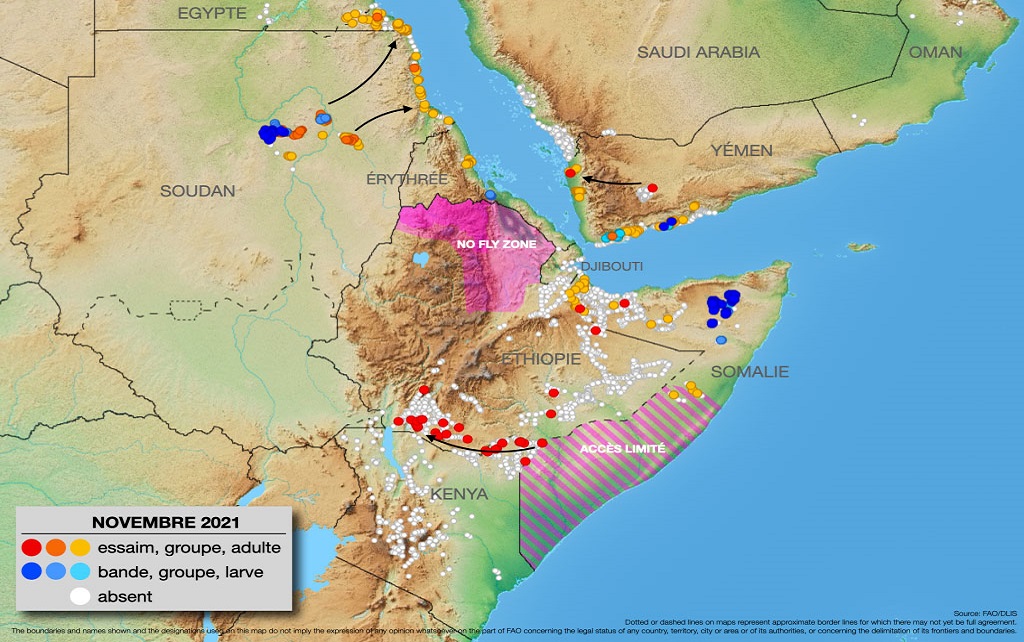
Situation and forecast.
24 November 2021. A few swarms in Southern Ethiopia
OVERVIEW. A few small mature swarms, most likely those that arrived on the Ethiopia/Kenya border earlier this month, have concentrated in southern Ethiopia between Konso and the Kenya border where control operations are underway. There have been no further reports of locusts in Kenya and elsewhere in Ethiopia. Aerial and ground control operations continue against small hopper bands in northeast Somalia while scattered adults persist in the northwest. Limited ground control operations are underway on the central Red Sea coast of Eritrea between Faro and Gelalo where groups of hoppers are present from earlier breeding by swarms that originated from northeast Ethiopia. Small-scale breeding continues on the southern coast of Yemen where hoppers and a few small groups of adults are present. No reports from Sudan.
WHY IT MATTERS. The swarms that arrived in southern Ethiopia are likely to breed, giving rise to small hopper bands in December. Some breeding may also extend to border areas in northern Kenya from Mandera to Marsabit. In northeast Somalia, new swarms could start to form in about mid-December and small-scale breeding could occur in areas that receive rainfall on the northern plateau and northwest coast. Any breeding in eastern Ethiopia and central Somalia is likely to be extremely limited due to poor rainfall, which is not expected to improve. Therefore, the potential threat and scale of any swarm migration to Kenya towards the end of this year depends on the success of current survey and control operations in northern Somalia and the continuation of monitoring efforts and control, if necessary, in eastern Ethiopia. Intensive efforts should remain focused in Somalia, Ethiopia, and northern Kenya. Surveys should be increased in the winter breeding areas along both sides of the Red Sea. In Eritrea, a few small swarms could form in early December where they are likely to remain and eventually breed.
CONTEXT. Current breeding continues to be confined by poor rains in the Horn of Africa.
• SOMALIA. Control operations continue against small hopper bands in the NE that could form swarms in mid-December; solitarious adults in the NW that may breed.
• ETHIOPIA. A few mature swarms seen in southern Oromia near the Kenya border.
• KENYA. No locusts seen in the past two weeks, but breeding could occur along northern border.
• ERITREA. A few small swarms may form in early December from current hoppers groups on the central Red Sea coast.
• YEMEN. Breeding expected on the Red Sea coast.
• SAUDI ARABIA. No locusts in the southwest but may arrive from nearby Yemen.
TAKEAWAY. Intensify current survey and control efforts to reduce breeding in the Horn of Africa.
• Central Region (SERIOUS) – maintain operations (Ethiopia, Somalia); increase operations (Eritrea, N. Kenya, Yemen)
• Western Region (CALM) – no significant activities
• Eastern Region (CALM) – no significant activities
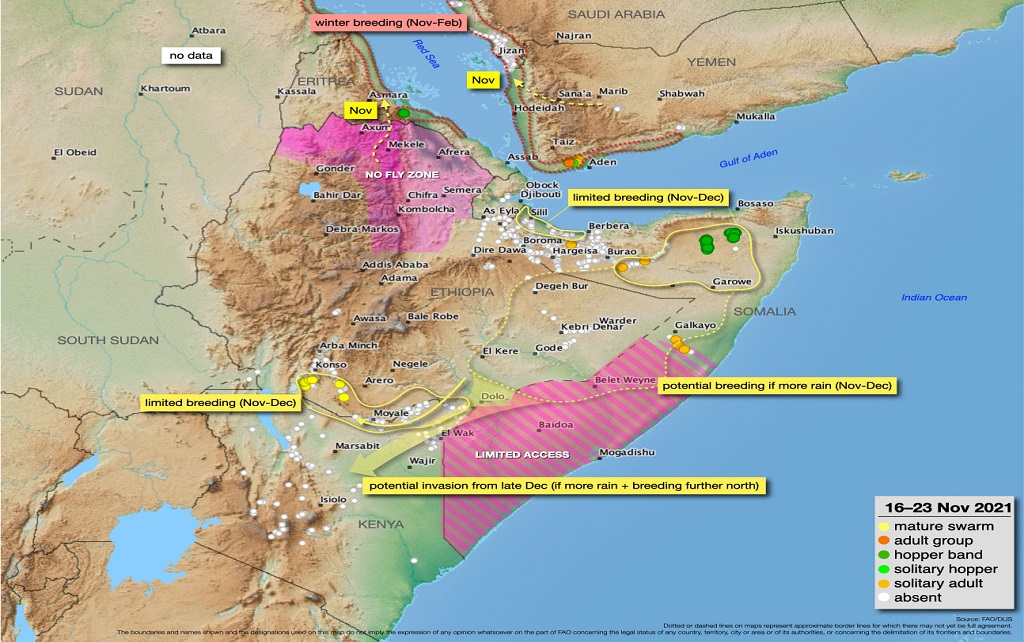
Situation and forecast.
11 November 2021. Poor rains may limit breeding
OVERVIEW. At least one more small mature swarm arrived in northeast Kenya three days ago. About three separate swarms have arrived since 1 November; however, it is difficult to be precise because the swarms tend to split up, sometimes regroup, cross back and forth into southern Ethiopia, and are often reported more than once as they move west from Mandera towards Moyale. In Somalia, small early instar hopper bands are present in the northeast from local breeding while more solitarious adults were seen along the Ethiopian border in the northwest. In Yemen, breeding is underway along parts of the southern coast and a few small hopper bands have formed. Surveys are yet to commence in winter breeding areas on the Red Sea coastal plains. No locusts have been seen in adjacent areas of southwest Saudi Arabia. No reports from Eritrea and Sudan.
WHY IT MATTERS. The small mature swarms that have appeared so far in northeast Kenya and the possibility of a few more small swarms arriving in the coming weeks means that limited breeding is likely to occur in the extreme north of Mandera, Wajir, and Marsabit counties near the Ethiopia border, causing small hopper bands to form in December. In Somalia, new forms could start to form in about mid-December from current hopper bands in the northeast and small-scale breeding could commence shortly in the northwest. However, breeding elsewhere along the plateau in northern and central Somalia as well as adjacent areas of eastern Ethiopia to nearly the Juba River is likely to be very limited since little rain has fallen in the past month. According to the latest predictions, more rainfall is unlikely in these areas in the coming month. Therefore, the potential threat and scale of any swarms migrating to Kenya towards the end of this year will depend on the success of current survey and control operations in northern Somalia, the continuation of supplementary survey and control efforts in eastern Ethiopia, and whether more rains fall during the next four weeks. Given these uncertainties, intensive efforts should be focused on Somalia, Ethiopia, and northern Kenya. As current breeding on the southern coast of Yemen is likely to cause locust numbers to increase, survey and control efforts should be upscaled. A few swarms from northern Ethiopia and the interior of Yemen are still expected to appear in the winter breeding areas along the Red Sea coast of Eritrea and Yemen, respectively.
CONTEXT. Current breeding has been limited by poor rains in the Horn of Africa.
• SOMALIA. Control operations continue against small early instar hopper bands in the NE; solitarious adults in the NW that may breed.
• ETHIOPIA. A few mature swarms seen near the Kenya border.
• ERITREA. A few small swarms from northern Ethiopia likely to appear on the Red Sea coast.
• YEMEN. Small hopper bands form on the southern coast from local breeding; a few small swarms from the interior may reach the Red Sea coast.
• SAUDI ARABIA. No locusts in the southwest but may arrive from nearby Yemen.
TAKEAWAY. Intensify current survey and control efforts to reduce breeding in the Horn of Africa.
• Central Region (SERIOUS) – maintain operations (Ethiopia, Somalia); increase operations (Eritrea, N. Kenya, Yemen)
• Western Region (CALM) – no significant activities
• Eastern Region (CALM) – no significant activities
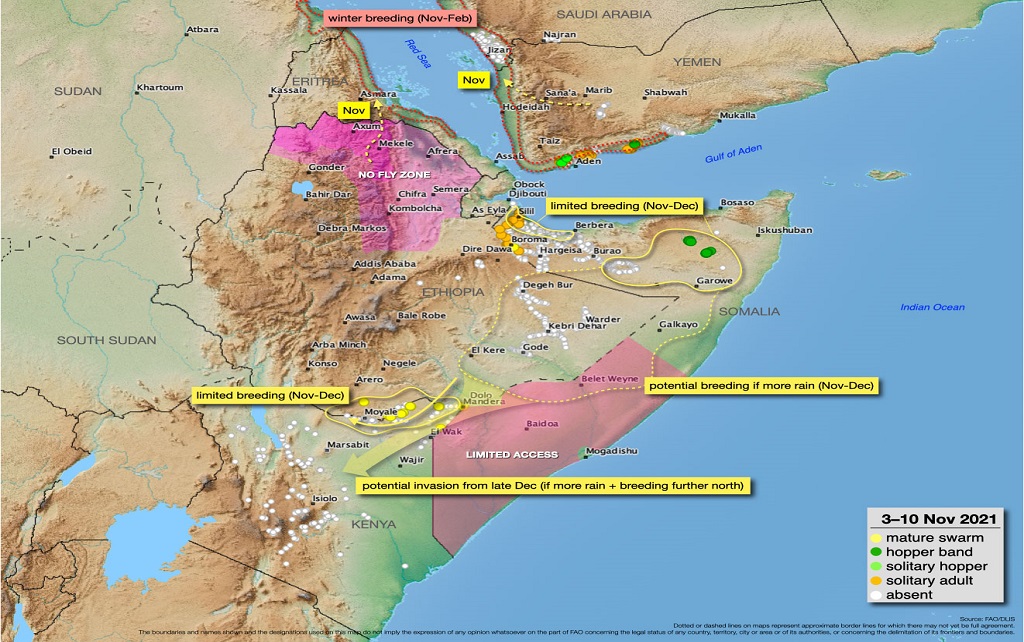
Situation and forecast.
3 November 2021. Swarm arrives in NE Kenya & Eritrea
OVERVIEW. In the afternoon of 1 November, a small mature swarm arrived in Mandera county of northeast Kenya near the Ethiopia border west of Rhamu. Since then, the swarm moved about 100 km west towards Moyale. The swarm is thought to have come from northeast Somalia and migrated south along the Ethiopia/Somalia border during three days of unusually strong and persistent northerly winds as suggested by sightings in eastern Ethiopia and central Somalia as well as by a trajectory model. While the swarm is mature, it is not quite ready to lay eggs yet. This may suggest how it was able to migrate a relatively long distance. Elsewhere, a mature swarm from northern Ethiopia arrived on the southern Red Sea coast in Eritrea at the end of October.
WHY IT MATTERS. The arrival of the swarm in Kenya does not suggest a full-scale invasion of large numerous swarms. Instead, it indicates that a few small swarms are moving south from northeast Somalia where most of the swarms are remaining to lay eggs that are now hatching and forming small hopper bands. Breeding during November is expected to occur mainly on the plateau and northwest coast in northern Somalia and in the Somali region of eastern Ethiopia as far south as the Shabelle River. However, a few of the less mature swarms could continue further south towards Kenya at times in the coming weeks, arriving in the northeast where they are likely to move west along the Ethiopia border. This further confirms the strategic importance of maximizing efforts now to monitor and control the situation in eastern Ethiopia and northern Somalia to reduce breeding during November and the anticipated formation of new swarms from about mid-December onwards when the prevailing winds over the Horn of Africa will be from the north. The success of these efforts will determine the potential threat to Kenya at the end of this year. In any case, monitoring and preparedness should be upscaled immediately in northern Kenya, and control operations undertaken whenever possible. The swarm that arrived in Eritrea confirms that some swarms are present in Tigray, Amhara and Afar regions of northern Ethiopia where insecurity prevents field operations. FAO first warned in late August that swarms were likely to migrate to Eritrea in October, and a few more swarms could appear this month and reach the Red Sea coast for winter breeding.
CONTEXT. A new generation of breeding is commencing in eastern Ethiopia and northern Somalia.
• SOMALIA. Hatching and hopper band formation are underway in the NE and likely in the NW
• ETHIOPIA. A few mature swarms in eastern Somali region; breeding expected.
• ERITREA. A mature swarm in late October on the Red Sea coast near Mersa Fatma; a few more expected.
• YEMEN. A few bands and swarms in the interior; shift to Red Sea coast is expected.
• SAUDI ARABIA. No locusts in the southwest.
• SW ASIA. No locusts in Iran, Pakistan, and India.
• WEST AFRICA. Calm.
TAKEAWAY. Start surveys on the Red Sea coast in Eritrea; increase ground surveys in Ethiopia and Somalia; increase monitoring and preparedness in N Kenya.
• Central Region (SERIOUS) – increase ground surveys (Eritrea, Ethiopia, Kenya, Somalia, Yemen)
• Western Region (CALM) – no significant activities
• Eastern Region (CALM) – no significant activities
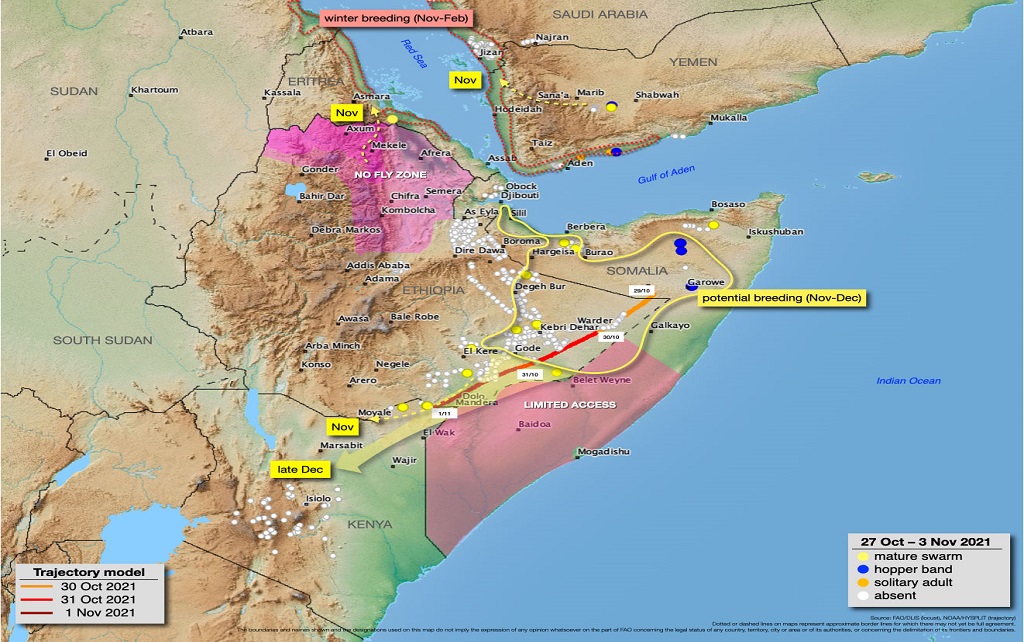
Situation and forecast.
14 October 2021. Swarms likely to move from NE Ethiopia
OVERVIEW. The few spring-bred swarms that have remained in northeast Somalia are now mature and starting to copulate. No swarms have been reported recently in northwest Somalia, Djibouti, or Ethiopia. Nevertheless, a few summer-bred swarms are likely to have formed in parts of Afar and adjacent areas of southeast Tigray and eastern Amhara regions. Unfortunately, this cannot be confirmed as most areas are not accessible. No surveys have been conducted recently in Yemen where a few summer-bred swarms are likely to be present in parts of the interior. In Sudan, only low numbers of scattered adults are present in the interior with local breeding in the Bayuda Desert north of Khartoum where a few groups are forming as vegetation dries out. Elsewhere, the situation remains calm.
WHY IT MATTERS. As vegetation dries out in the breeding areas of northeast Ethiopia, any swarms that form are expected to migrate north through the Ethiopian Highlands to the Red Sea coast of Eritrea and southeast to eastern Ethiopia and northern Somalia. Although the scale of this migration is nearly impossible to predict due to conflict and a lack of reporting, the swarm numbers and sizes should be limited and certainly much less than last year at this time. In any case, breeding is likely to occur in areas that receive rainfall during October and November in the Somali region of eastern Ethiopia, on the plateau in northern Somalia, on the coast of northwest Somalia, and the Red Sea coast in Eritrea. Similarly, a limited number of swarms will migrate from the summer breeding areas in the interior of Yemen to the Red Sea and Gulf of Aden coastal plains for winter breeding. There is a low risk that a few small swarms could eventually reach the coast of Sudan and Saudi Arabia while others may cross the Gulf of Aden from Yemen to northern Somalia. Given the current uncertainty of the scale of migration and upcoming rains, surveys should be mounted in the above areas and maintained until at least the end of this year and early next year. While every effort should be made to reduce the number of swarms before they lay eggs, this may not be entirely possible so control against the new generation of hopper bands is likely to be required towards the end of this year.
CONTEXT. Insecurity hampers field operations in parts of northern Ethiopia and Yemen.
• SOMALIA. The few remnant swarms have matured in the northeast where they are copulating.
• ETHIOPIA. No locusts seen in Somali region and parts of central Afar.
• DJIBOUTI. No locusts in the east.
• YEMEN and ERITREA. No recent surveys.
• SUDAN. Calm; few hopper and adult groups in the Bayuda Desert north of Khartoum.
• SAUDI ARABIA. No locusts in the southwest.
• WEST AFRICA. Calm.
• SW ASIA. No locusts in Iran, Pakistan, and India.
TAKEAWAY. Current field operations in Somalia and Ethiopia should be maintained while surveys should start on the Red Sea coast in Eritrea.
• Central Region (SERIOUS) –increase surveys (Djibouti); maintain surveys (N Somalia, E Ethiopia); start surveys on Red Sea coast (Eritrea)
• Western Region (CALM) – improve monitoring and reporting (Mauritania, Niger)
• Eastern Region (CALM) – no significant activities

Situation and forecast.
1 October 2021. More swarms forming in NE Ethiopia
The locust situation remains serious in the Horn of Africa and Yemen.
As anticipated, new immature swarms began to form after mid-September in the summer breeding areas of northeast Ethiopia and most likely in adjacent areas of the northern highlands where hopper bands were reported. The scale of the breeding is not well known, and control operations could not be conducted due to insecurity. Although limited field operations began to resume in some areas by the end of the month, more small immature swarms will form in Afar, Tigray, and Amhara regions of Ethiopia during October. As vegetation dries out, they will migrate north through the highlands to Eritrea and the Red Sea coast as well as east perhaps through Djibouti at times to eastern Ethiopia and northern Somalia.
October rains that are expected in the Somali region of eastern Ethiopia and adjacent plateau and coastal areas of northern Somalia will allow the summer-bred swarms and the remaining spring-bred swarms to mature and lay eggs, giving rise to hatching and hopper band formation from about early November onwards. Similarly, any swarms that reach the Red Sea coast of Eritrea from northern Ethiopia are likely to mature and breed once winter rains commence.
Although limited control operations were carried out in the interior of Yemen, more small swarms are expected to form and move to coastal areas along the Red Sea and Gulf of Aden for eventual breeding. A few swarms may cross to northern Somalia while any swarms that reach the Red Sea coast of Yemen could continue to adjacent coastal areas of southwest Saudi Arabia.
Elsewhere, the situation is calm.

Situation and forecast.
23 September 2021. New swarms forming in NE Ethiopia
OVERVIEW. As expected, new summer-bred immature swarms have started to form in the past few days between the Awash and Mille rivers in the Afar region of northeastern Ethiopia where late instar hopper bands are still present. The scale of the breeding, which is likely to extend to other areas of Afar as well as adjacent areas of southeast Tigray and eastern Amhara regions, is not well known as most places cannot be accessed by ground teams and there is an imposed No Fly Zone for survey and control aircraft. Small remnant spring-bred immature swarms are present in eastern Ethiopia between Dire Dawa and Djibouti, and on the plateau in northwest and northeast Somalia. Survey and control operations are in progress in all these areas. In Yemen, more immature swarms are forming from hopper band infestations in the interior. However, field operations are somewhat limited due to beekeepers and new areas of conflict. Elsewhere, the situation remains calm.
WHY IT MATTERS. More immature swarms will form during the coming weeks in the inaccessible breeding areas of northeast and northern Ethiopia. As vegetation dries out, the swarms are expected to move northwards through the highlands of Tigray to reach the Red Sea coastal plains in Eritrea and eastwards to the Somali region in eastern Ethiopia and adjacent areas of northern Somalia to join remnant spring-bred swarms that are still present. While below-average rains are forecasted for October and November, they should be sufficient to allow the swarms to mature and lay eggs, which will hatch and give rise to hopper bands until the end of the year. In addition, any swarms that cannot be treated in the interior of Yemen are likely to move during October to the Red Sea coast of Yemen and perhaps across the Gulf of Aden to northern Somalia and eastern Ethiopia.
CONTEXT. Insecurity is hampering field operations in parts of Ethiopia and Yemen.
• SOMALIA. A few remnant immature swarms in the northwest and northeast.
• ETHIOPIA. Hopper bands with new immature swarms forming in Afar (Mille zone); remnant swarms south of Djibouti.
• DJIBOUTI and ERITREA. No surveys.
• YEMEN. Hopper bands and more new swarms forming in the interior; limited control only.
• SUDAN. Calm with a few groups of hoppers and adults in the interior.
• SAUDI ARABIA. No locusts in the southwest.
• WEST AFRICA. Calm with local breeding in Mali and Chad.
• SW ASIA. No locusts in Iran, Pakistan, and India.
TAKEAWAY. Current field operations in northern Somalia and eastern Ethiopia should be maintained while upscaling of surveys is needed in northern Ethiopia and southern Djibouti.
• Central Region (SERIOUS) – increase operations (Djibouti, northern Ethiopia); vigilance (Eritrea)
• Eastern Region (CALM) – continue summer surveys (Indo-Pakistan)
• Western Region (CALM) – improve monitoring and reporting (Mauritania, Niger)
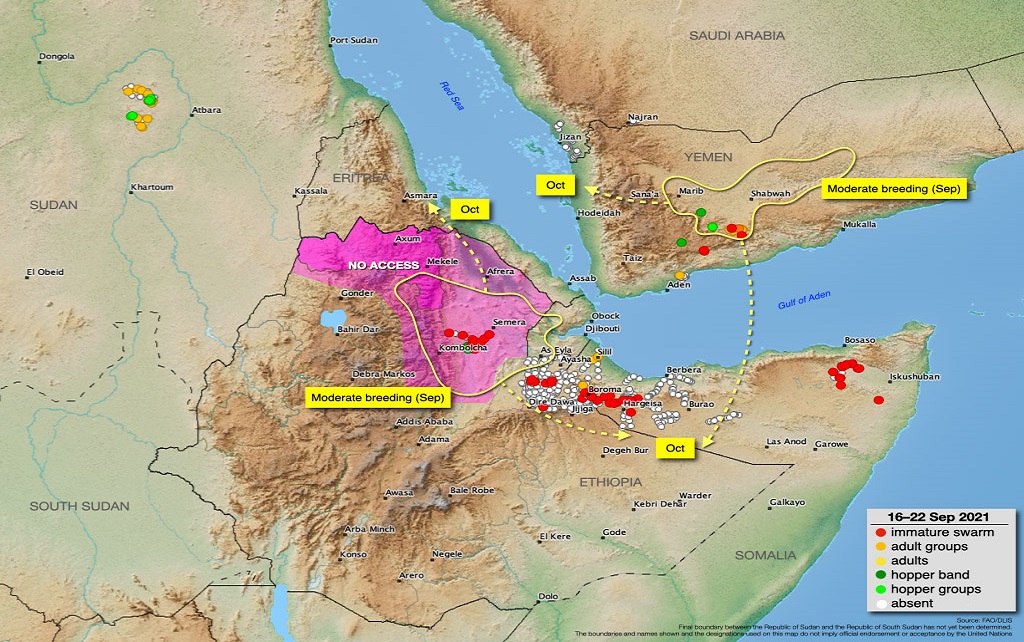
Situation and forecast.
16 September 2021. Breeding in Northern Ethiopia
OVERVIEW. New reports confirm that breeding is underway in at least four woredas of southeast Tigray in northern Ethiopia where hoppers are forming small bands. Reports were also received of early instar bands in adjacent areas of Afar and probably eastern Amhara regions. A few small immature swarms appeared in the past days near Ayasha along the railway area in eastern Ethiopia just south of Djibouti and on the plateau in northwest and northeast Somalia. These swarms are remnants from spring breeding rather than newly formed summer-bred swarms, which will not occur for another three weeks or so. In Yemen, more small immature swarms are forming from local breeding and hopper bands that are present in the southern interior. Elsewhere, the situation remains calm with only small-scale breeding in areas of recent rainfall in Chad and Sudan.
WHY IT MATTERS. Summer breeding in Ethiopia has extended beyond the Afar region into the highlands of southeast Tigray and eastern Amhara. Survey and control operations have been compromised in all areas due to insecurity and inaccessibility since July. It is hoped that safe access can be restored; otherwise, it will be difficult to treat current hopper band infestations and reduce the formation of swarms that is likely to commence in early October. Once vegetation dries out in the current breeding areas of northern and northeastern Ethiopia, the new swarms are expected to move northwards through the highlands to reach the Red Sea coastal plains in Eritrea and eastwards to the Somali region in eastern Ethiopia and adjacent areas of northern Somalia to join any remnant spring-bred swarms that may still be present. Rainfall during October and November would allow the swarms to mature and ecological conditions to be favourable for egg-laying, hatching and hopper band formation until the end of the year. In addition, any swarms that are not treated in the interior of Yemen are likely to move during October to the Red Sea coast of Yemen and perhaps across the Gulf of Aden to northern Somalia and eastern Ethiopia. Consequently, the current upsurge is likely to continue, albeit at a lower level than one year ago, during the remainder of this year.
CONTEXT. Continued insecurity is prolonging the current upsurge in the Horn of Africa.
• SOMALIA. A few remnant immature swarms in the northwest and northeast.
• ETHIOPIA. Hopper bands in Afar (Mille zone) and SE Tigray; hatching in Afar and Amhara; immature swarm near Ayasha (Somali); only limited operations due to insecurity and New Year.
• DJIBOUTI and ERITREA. No surveys.
• YEMEN. Hopper bands and new swarms forming in the interior; limited control underway.
• SUDAN. Calm with low numbers of adults and small-scale breeding in the interior.
• SAUDI ARABIA. No locusts in the southwest; no invasions are expected.
• W AFRICA. Calm with low numbers of adults and small-scale breeding in Chad.
• SW ASIA. No locusts in Iran, Pakistan, and India.
TAKEAWAY. Current field operations in northern Somalia and eastern Ethiopia should be maintained while upscaling of surveys is needed in northern Ethiopia and southern Djibouti.
• Central Region (SERIOUS) – increase operations in Djibouti and northern Ethiopia
• Eastern Region (CALM) – continue summer surveys (Indo-Pakistan)
• Western Region (CALM) – continue summer surveys (northern Sahel)

Situation and forecast.
8 September 2021. Locusts in Northern Ethiopia
OVERVIEW. New reports indicate that hoppers bands are forming in eastern Amhara region of northern Ethiopia and swarms were seen in Tigray southwest of Mekele. Hopper bands are almost certainly forming in the Afar region but breeding areas cannot be accessed due to conflict. A few immature swarms persist in the hills of northeast Somalia where access is difficult. Hopper bands and new immature swarms are forming in the interior of Yemen where ground control operations are limited due to the presence of beekeepers. Elsewhere, the situation remains calm in the summer breeding areas from Mauritania to Eritrea and along both sides of the Indo-Pakistan border.
WHY IT MATTERS. The reports of hopper bands in Amhara and swarms in Tigray confirm earlier suspicions that breeding has extended beyond Afar into the highlands of northern Ethiopia. The swarms in Tigray are most likely mature and probably found suitable areas for breeding. As the current situation does not allow survey and control operations, new swarms are expected to form in northern and northeast Ethiopia in October that would threaten Eritrea (moving through the highlands to reach the Red Sea coastal plains), eastern Ethiopia (Somali region) and northern Somalia (northwest coast and plateau) where rains generally start in about October or November. This would allow the summer-bred swarms to mature and lay eggs, giving rise to another generation of hopper bands before the end of the year. While the scale of current breeding is less than a year ago, the inability to undertake field operations in northern and northeast Ethiopia is of grave concern. In Yemen, it was expected that new swarms would form in the interior this month, but it is worrisome that control operations against current hopper bands to reduce the number of new swarms may be compromised by beekeepers. If so, this could lead to an increased risk of a few swarms invading northern Somalia in October or November.
CONTEXT. Continued insecurity is prolonging the current upsurge in the Horn of Africa.
• SOMALIA. A few swarms in the northeast (Puntland); no locusts in the northwest (Somaliland).
• ETHIOPIA. Hopper band formation likely in Afar, Amhara and Tigray; only limited operations possible in Amhara due to insecurity; no locusts in Somali region.
• DJIBOUTI. Late instar hopper band in interior of Tadjourah region.
• YEMEN. Hopper bands and new swarms forming in the interior; limited control underway.
• SUDAN. Calm with low numbers of adults and small-scale breeding in the interior.
• SAUDI ARABIA. No locusts in the southwest; no invasions are expected.
• W AFRICA. Calm with low numbers of adults and small-scale breeding in Chad.
• SW ASIA. No locusts in Iran, Pakistan, and India.
TAKEAWAY. Current field operations in northern Somalia and eastern Ethiopia should be maintained while upscaling of surveys is needed in northern Ethiopia and southern Djibouti.
• Central Region (SERIOUS) – increase operations in Djibouti and, if possible, northern Ethiopia
• Eastern Region (CALM) – continue summer surveys (Indo-Pakistan)
• Western Region (CALM) – continue summer surveys (northern Sahel)

Situation and forecast.
25 August 2021. Remnant swarms in N Somalia
OVERVIEW. A few small immature swarms remain on the plateau in northwest Somalia while several more immature swarms were seen recently in the northeast as a result of arrivals from northwest Somalia and undetected local breeding. Aerial control operations are underway in both areas. Hatching and the formation of small hopper bands are almost certainly underway in northeast Ethiopia, but this could not be confirmed as the area cannot be accessed due to security concerns. In Yemen, a few hopper bands have formed on the southern coast and small-scale breeding is underway in the interior. Elsewhere, the situation remains calm, and no significant developments are likely.
WHY IT MATTERS. It was anticipated that there was a good possibility to bring the current upsurge to an end with an effective control campaign this summer in northeast Ethiopia. However, ground and aerial teams are unable to access the breeding locations in the Afar region to conduct survey and control operations due to insecurity. Consequently, locusts will continue to increase unabated in that region and new immature swarms are likely to start forming in the last days of September and continue into October. As vegetation dries out in Afar, some of the swarms are likely to migrate north towards the winter breeding areas along the coast in Eritrea while others will move east to the eastern Somali region in Ethiopia and adjacent areas of northern Somalia. The extent of subsequent breeding in both areas is difficult to predict because it depends on the scale of summer breeding in northeast Ethiopia, which is not likely to be well known, and rains that fall during the last quarter of this year. Contingency preparations will need to be taken to address these uncertainties.
CONTEXT. Continued insecurity could prolong the current upsurge in the Horn of Africa.
• SOMALIA. Limited aerial control operations continue against a few remnant immature swarms on the plateau and coast in the northwest (Somaliland); a few more swarms were sighted in the northeast (Puntland) likely from earlier undetected local breeding and arriving from the northwest.
• ETHIOPIA. Hatching and hopper band formation likely to be underway in Afar but cannot be confirmed or addressed due to insecurity and no access; no locusts in Somali region.
• YEMEN. Limited hopper bands on southern coast; small-scale breeding in the interior.
• SUDAN. Scattered adults in the interior where small-scale breeding likely to be underway.
• SAUDI ARABIA. No locusts in the southwest; no invasions are expected.
• W AFRICA. Scattered adults in Chad and small-scale breeding likely to be in progress.
• SW ASIA. No locusts seen during recent surveys in Iran, Pakistan, and India.
TAKEAWAY. Current field operations in northern Somalia should be maintained while upscaling of surveys is needed in northeast Ethiopia and Djibouti.
• Central Region (SERIOUS) – increase operations in Djibouti and, if possible, northeast Ethiopia
• Eastern Region (CALM) – continue summer surveys (Indo-Pakistan)
• Western Region (CALM) – continue summer surveys (northern Sahel)
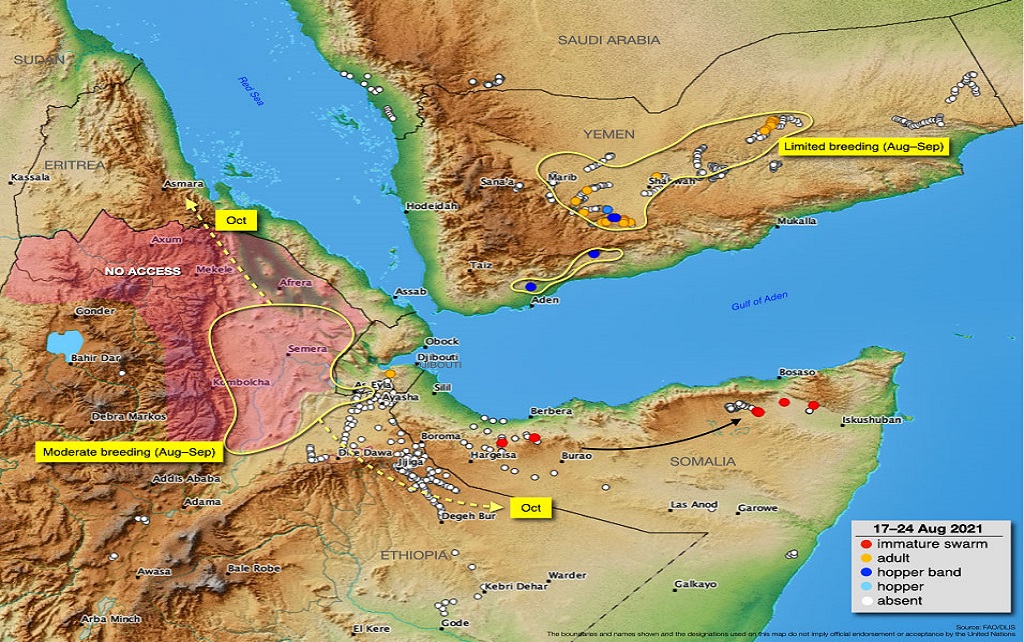
Situation and forecast.
12 August 2021. Breeding likely in Northeast Ethiopia
OVERVIEW. Aerial control operations continue against a few small immature swarms on the plateau in northwest Somalia while one swarm was seen in the northeast. Limited swarm breeding is thought to be underway in northern Ethiopia where good rains have fallen, but the security situation has deteriorated in the Afar region during the past week, hampering survey and control operations by air and ground. In Yemen, small-scale breeding is underway in the interior. Elsewhere, the situation remains calm, and no significant developments are likely.
WHY IT MATTERS. Swarms are not likely to move from Ethiopia and Somalia to Eritrea, Sudan, Yemen, and Saudi Arabia now. Instead, the swarms in northern Somalia may move back and forth across the Ethiopia/Somalia border where they are likely to persist and remain immature due to dry conditions. The mature swarms in northeast Ethiopia will finish laying eggs in areas of recent rain, including adjacent areas of southern Djibouti. Hatching and band formation are expected to take place this month in Afar, causing locust numbers to increase and leading to the formation of new immature swarms from late September onwards. Although the scale of the anticipated breeding will be much smaller than in the past two years, if the necessary survey and control operations cannot be carried out safely in Afar, then a greater number of swarms are likely to form than originally anticipated that would migrate east and threaten eastern Ethiopia and northern Somalia in October.
CONTEXT. Continued insecurity could prolong the current upsurge in the Horn of Africa.
• SOMALIA. Aerial control operations continue against a low number of immature swarms that persist on the plateau in the northwest (Somaliland). At least one small swarm moved east to the northeast (Puntland) in the past week. A few swarms are likely to stay on the plateau and remain immature.
• ETHIOPIA. Low numbers of mature swarms are likely to be present and laying eggs in areas of recent rainfall in Afar with hatching and band formation imminent. However, most all areas can no longer be accessed due to a recent deterioration in security.
• YEMEN. Good rains fell in parts of the interior and small-scale breeding is underway with a few groups of hoppers and adults; no invasions are expected.
• SUDAN. Scattered adults in the interior where small-scale breeding will occur; no invasions are expected.
• SAUDI ARABIA. No locusts in the southwest; no invasions are expected.
• W AFRICA. Scattered adults in Niger and Chad where small-scale breeding will occur.
• SW ASIA. No locusts seen during recent surveys in Iran, Pakistan, and India.
TAKEAWAY. Current field operations in northern Somalia should be maintained while upscaling of surveys is needed in northeast Ethiopia and Djibouti.
• Central Region (SERIOUS) – increase operations in Djibouti and, if possible, northeast Ethiopia
• Eastern Region (CALM) – continue summer surveys (Indo-Pakistan)
• Western Region (CALM) – continue summer surveys (northern Sahel)

Situation and forecast.
5 August 2021. Favourable breeding conditions
OVERVIEW. In the past week, only a very few mature swarms have been detected in northeast Ethiopia (Afar region) while several swarms remain immature on the plateau in northwest Somalia. The prevailing strong winds and cool temperatures have limited swarm activity in northwest Somalia as well as control operations, which are just now increasing as the winds have dropped in the past few days. No control has been carried out in Ethiopia due to a lack of targets and some areas could not be surveyed because of persistent accessibility issues. In Yemen, surveys are increasing in the interior where only low numbers of locusts are currently present.
WHY IT MATTERS. Good rains have fallen in northeast Ethiopia and parts of southern Djibouti that have caused conditions to become favourable for breeding. It is now critical for ground and aerial teams to find and treat any remaining mature swarms before they lay eggs to limit breeding. But it will also be necessary to prepare for eventual control operations against hopper bands that will form once hatching takes place later this month, especially in those areas where breeding could not be detected. Nevertheless, the upcoming breeding and control operations are expected to be on a much smaller scale than in the past two years and will be concentrated mainly in the Afar region.
CONTEXT. The start of breeding is likely to be underway in the summer breeding areas.
• SOMALIA. Aerial control operations continue, whenever possible, against several immature swarms that remain on the escarpment and plateau in the northwest (Somaliland). Additional ground teams are being deployed.
• ETHIOPIA. Low numbers of mature swarms are likely to be present and laying eggs in areas of recent rainfall in Afar. However, few swarms have been seen recently by field teams and some areas cannot be fully accessed.
• YEMEN. An immature swarm was moving about in the southern highlands, and low numbers of adults are present in the interior where good rains fell earlier.
• ERITREA. Low numbers of adults in the western lowlands near the Ethiopia border for summer breeding.
• SUDAN. Scattered adults in the interior for summer breeding.
• W AFRICA. Scattered adults in Niger and Chad for summer breeding.
• SW ASIA. No locusts seen during recent surveys in Iran, Pakistan and India.
TAKEAWAY. Current field operations in northern Somalia should be maintained while upscaling of surveys is needed in northeast Ethiopia and Djibouti.
• Central Region (SERIOUS) – increase operations in northeast Ethiopia and southern Djibouti
• Eastern Region (CALM) – continue summer surveys (Indo-Pakistan)
• Western Region (CALM) – continue summer surveys (northern Sahel)
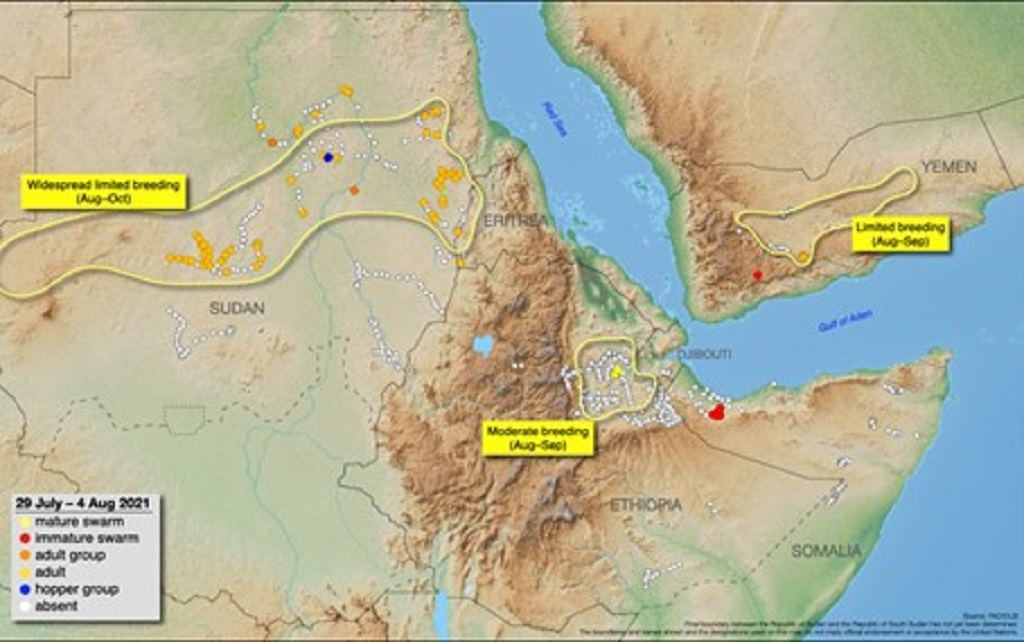
Situation and forecast.
29 July 2021. Good rains in Djibouti and NE Ethiopia
OVERVIEW. A few small immature swarms persist in northwest Somalia where aerial survey and control operations continue on the plateau and escarpment. The situation is less clear in northeast Ethiopia because surveys are limited since many areas are difficult to access now. As good rains have fallen in the Afar region during the past week, some swarms are almost certainly present and probably ready to lay eggs. Some early egg-laying may have already occurred in parts of Afar. The situation is likely to be similar in southern Djibouti where unusually good rains fell in the past days. In Yemen, an immature swarm reached the southern edge of the summer breeding area in the interior where good rains have fallen recently.
WHY IT MATTERS. While effective control operations in northwest Somalia have reduced the scale of swarm migration to northeast Ethiopia, the upcoming months will be crucial in determining the continuation of the upsurge. One generation of summer breeding is expected to occur during August and September in the Afar region of Ethiopia, which is likely to extend into adjacent areas of southern Djibouti. Consequently, new summer-bred swarms could start to form from late September onwards. In the next few weeks, the situation may seem to be calm with few locust reports as the current swarms finish laying eggs and before the subsequent hopper bands are detected. Nevertheless, it is important to maintain and upscale surveys to detect the location and scale of breeding and plan control operations.
CONTEXT. Important infestations remain in parts of the Horn of Africa while other regions are calm.
• SOMALIA. Aerial control operations continue against a few remaining immature swarms on the escarpment and plateau in the northwest (Somaliland). Swarm movement remains limited due to cooler temperatures on the plateau and strong winds.
• ETHIOPIA. No reports of locusts due to access issues in Afar but there are unconfirmed sightings of swarms in a few areas. Other swarms are likely to be present and breeding is imminent in areas of recent rainfall. Aerial operations have shifted from Kombolcha to Dire Dawa.
• YEMEN. An immature swarm seen earlier in the highlands has reached the southern edge of the summer breeding areas near Ataq in the interior. Despite a lack of surveys this past week, small-scale breeding is expected to be continuing in parts of the interior where good rains have fallen.
• SW ASIA. No locusts seen during recent surveys in Iran, Pakistan and India.
TAKEAWAY. Current field operations in northern Somalia should be maintained while upscaling of surveys is needed in northeast Ethiopia, Djibouti and Yemen.
• Central Region (SERIOUS) – increase operations in northeast Ethiopia and southern Djibouti
• Eastern Region (CALM) – continue summer surveys (Indo-Pakistan)
• Western Region (CALM) – continue summer surveys (northern Sahel)
Situation and forecast.
22 July 2021. Swarms mature with rains in NE Ethiopia
OVERVIEW. As a result of ongoing intensive aerial control operations, the number and size of immature swarms in northwest Somalia continues is declining. Strong winds have limited swarm movement and hamper aerial operations at times. Although no new swarms have arrived in northeast Ethiopia during the past week, good rains have fallen and some of the swarms have moved towards the western lowlands of Afar where they have matured and are likely to be ready to lay eggs. A few swarms may have reached the highlands in Amhara and eastern Tigray where they are expected to continue to the summer breeding areas in Sudan. In Yemen, one immature swarm seen earlier in the highlands moved further south where it is likely to continue to areas of recent rainfall in the interior.
WHY IT MATTERS. Effective survey and control operations in northern Somalia and eastern Ethiopia are key in reducing breeding that will occur in northeast Ethiopia from now until September. Seasonal rains have commenced in Afar and above normal rainfall is expected during the next four weeks that will allow one generation of breeding between now and September. The current swarms will complete their maturation and lay eggs that should begin to hatch in early August, giving rise to hopper bands, which could eventually lead to the formation of new immature swarms from late September onwards. The risk of swarms from Yemen arriving in Afar continues to decline.
CONTEXT. Important infestations remain in the Horn of Africa while other regions are calm.
• SOMALIA. Aerial control operations continue against a few remaining immature swarms on the coast, escarpment and plateau in the northwest (Somaliland). Swarm movement is limited due to cooler temperatures on the plateau and strong winds.
• ETHIOPIA. Earlier swarms along the eastern escarpment of the Amhara highlands near Kombolcha have moved eastwards to the foothills and lowlands in western Afar where some have matured and ready to lay eggs in areas of recent rainfall. Aerial operations have shifted from Semera to Kombolcha.
• YEMEN. An immature swarm seen earlier in the highlands has moved further south to northeast of Aden; small-scale breeding is underway in parts of the interior where good rains have fallen.
• SW ASIA. No locusts seen during recent surveys in Iran, Pakistan and India.
TAKEAWAY. Current field operations should be upscaled in northeast Ethiopia and maintained in northern Somalia, Djibouti and Yemen.
• Central Region (SERIOUS) – increase operations in Afar and eastern Amhara (Ethiopia)
• Eastern Region (CALM) – continue summer surveys (Indo-Pakistan)
• Western Region (CALM) – continue summer surveys (northern Sahel)
Situation and forecast.
15 July 2021. Swarms continue in Northeast Ethiopia
OVERVIEW. Important Desert Locust infestations persist in the Horn of Africa where intensive aerial control operations are continuing against immature swarms in northwest Somalia and, to a lesser extent, in northeast Ethiopia where a few swarms are present along the eastern escarpment of the northern highlands in eastern Amhara and western Afar regions. Light rains have fallen in northwest Somalia and northeast Afar. Low numbers of swarms from northwest Somalia and perhaps Yemen are expected to appear in Afar during the coming week. A few of these swarms may move into the northern highlands where they should continue to the summer breeding areas in the interior of Sudan.
WHY IT MATTERS. Effective survey and control operations in northern Somalia and eastern Ethiopia are key in reducing breeding that will occur in northeast Ethiopia in the coming months. This is even more important as rains have already started to fall in Afar and are expected to be above normal from now until September. This will allow the swarms to finish their maturation and lay eggs, which are expected to start to hatch in early August, giving rise to hopper bands that could eventually lead to the formation of new immature swarms from late September onwards.
CONTEXT. Important infestations remain in the Horn of Africa while other regions are calm.
• SOMALIA. Mainly aerial control operations continue against immature swarms on the plateau in the northwest (Somaliland); no locusts seen during surveys in the northeast (Puntland).
• ETHIOPIA. Control operations are underway against earlier swarms that arrived and split up along the eastern escarpment of the Amhara highlands near Kombolcha. There are recent reports from a number of nearby districts as well as a swarm moving north towards Chifra today; a few immature swarms remain in the railway area near Ayasha.
• DJIBOUTI. An immature swarm is present north of Ali Sabieh.
• YEMEN. An immature swarm was seen in the highlands near Sana’a while another moved further south towards Taiz; small-scale breeding is underway in parts of the interior.
• SUDAN. Limited control was carried out against groups of hoppers and adults in the northern Nile Valley near Karima.
• SW ASIA. No locusts seen during recent surveys in Iran, Pakistan and India.
TAKEAWAY. Current field operations should be upscaled in northeast Ethiopia and maintained in eastern Ethiopia, northern Somalia, Djibouti and Yemen.
• Central Region (SERIOUS) – increase operations in Afar and eastern Amhara (Ethiopia)
• Eastern Region (CALM) – initiate summer surveys (Indo-Pakistan)
• Western Region (CALM) – initiate summer surveys (northern Sahel)

Situation and forecast.
8 July 2021. Swarms arriving in Northeast Ethiopia
OVERVIEW. Intensive aerial control operations continue against numerous immature swarms in northwest Somalia. Some of the swarms have started to migrate as there has been an increase in sightings and cross-border movements during the past few days in southern Djibouti, eastern Ethiopia and in the Afar region of northeast Ethiopia along the eastern escarpment of the Amhara Highlands. More swarms are expected to appear in Afar during the coming week and some may reach the northern highlands where they may continue to the summer breeding areas in the interior of Sudan. A few swarms could also arrive in Afar from Yemen.
WHY IT MATTERS. The effectiveness of current survey and control operations in northern Somalia and eastern Ethiopia will influence the magnitude of swarm migration to northeast Ethiopia. So far, migration has been limited but more swarms are likely to arrive this month, mature and lay eggs. The scale of the migration as well as the timing and location of July–September rainfall, which is predicted to be higher than normal this year, will determine the level of breeding this summer in the Afar region.
CONTEXT. Important infestations remain in the Horn of Africa while other regions are calm.
• SOMALIA. Mainly aerial control operations continue against immature swarms and the few remaining late instar hopper bands on the escarpment and plateau in the northwest (Somaliland); no locust seen during surveys in the northeast (Puntland).
• ETHIOPIA. A few immature swarms have arrived in Afar along the eastern escarpment of the Amhara highlands and one swarm continued into the highlands; other swarms are forming and appearing in the railway area near Ayasha where a few late instar hoppers bands are still present.
• DJIBOUTI. More immature swarms have been seen recently in the south coming from local breeding as well as adjacent areas of Somalia and Ethiopia.
• YEMEN. A few immature swarms persist in the highlands north of Sana’a; scattered adults are present in the interior where limited breeding is underway.
• SW ASIA. No locusts seen during recent surveys in Iran, Pakistan and India.
TAKEAWAY. Current field operations should be upscaled in northeast Ethiopia and maintained in eastern Ethiopia, northern Somalia, Djibouti and Yemen.
• Central Region (SERIOUS) – increase operations in Afar (Ethiopia)
• Eastern Region (CALM) – initiate summer surveys (Indo-Pakistan)
• Western Region (CALM) – initiate summer surveys (northern Sahel)
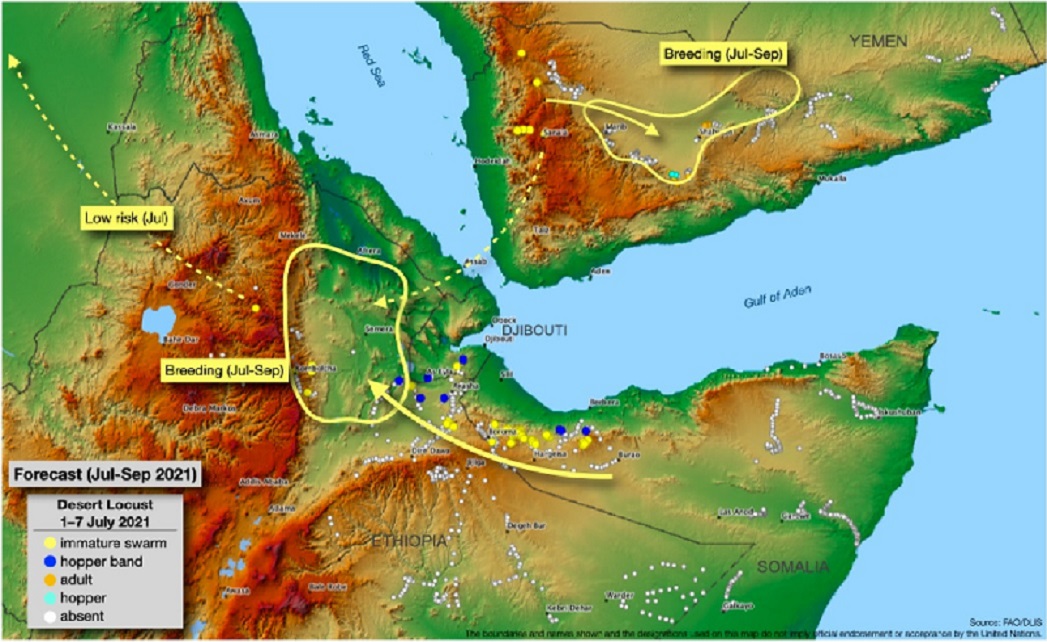
Situation and forecast.
2 July 2021. Swarms in Somalia
OVERVIEW. After an initial short-lived decline, immature swarms are increasing in northwest Somalia where control operations and local movements are in progress. There has been a recent increase in swarm sightings in adjacent areas of Ethiopia and Djibouti. While some of this may be due to local breeding, it may also be the first signs of the expected migration towards northeast Ethiopia. On 30 June, an immature swarm was seen on the eastern escarpment near the Amhara/Afar border. There is a risk that a few swarms could continue through the northern highlands to Sudan. In Yemen, a few swarms from the north appeared recently in the northern highlands. While most of these swarms should move to the interior for summer breeding, a few could migrate to Afar.
WHY IT MATTERS. The effectiveness of current survey and control operations in northern Somalia and eastern Ethiopia determines the scale of swarm migration to northeast Ethiopia. Similarly, the scale of breeding this summer in the Afar region is influenced by the number of swarms arriving from the east and Yemen, and rainfall from July to September, which is predicted to be higher than normal this year.
CONTEXT. Important infestations remain in the Horn of Africa while other regions are calm.
• SOMALIA. Aerial and ground operations reduced locust infestations on the coast, escarpment, and plateau in the northwest (Somaliland) where very few swarms have been seen in the past few days.
• ETHIOPIA. A few late instar hopper bands and several immature swarms are present in the railway area near Ayasha and the borders of Djibouti and Somalia.
• DJIBOUTI. Small late instar hopper bands and immature swarms are present in the south.
• SAUDI ARABIA. No locusts have been seen since 22 June.
• YEMEN. An immature swarm was seen in the highlands north of Sana’a on 30 June.
• SUDAN. Local breeding and scattered adults with a few small groups are present in the interior.
• SW ASIA. No locusts seen during recent surveys in Iran, Pakistan and India.
TAKEAWAY. Current field operations as well as extreme vigilance should be maintained in Ethiopia, northern Somalia, Djibouti and Yemen.
• Central Region (SERIOUS) – heightened alert and preparedness in Afar (Ethiopia)
• Eastern Region (CALM) – initiate summer surveys (Indo-Pakistan)
• Western Region (CALM) – initiate summer surveys (northern Sahel)
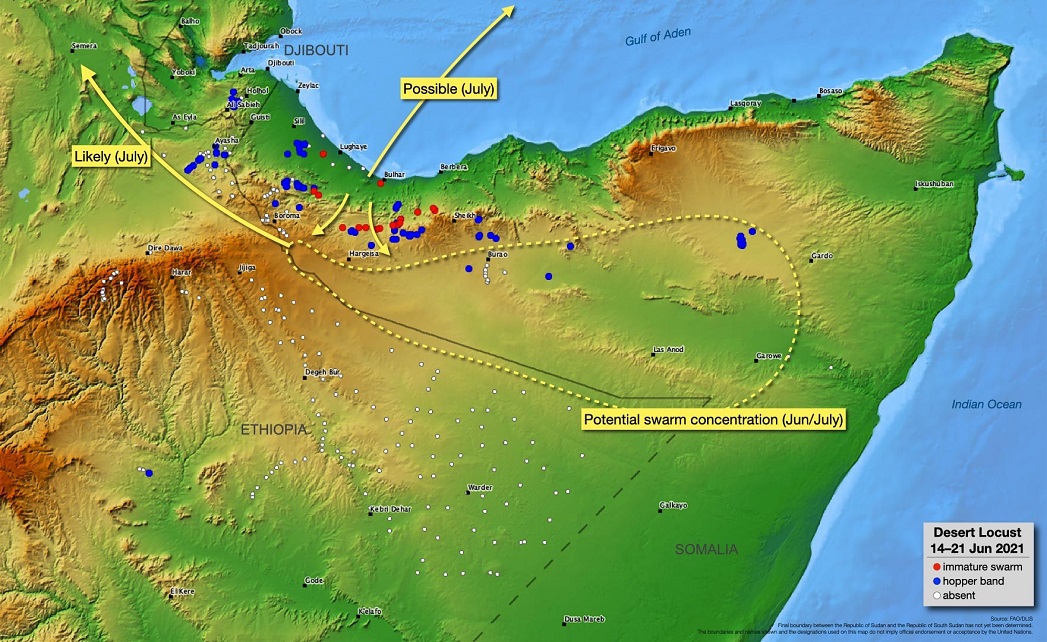
Situation and forecast.
29 June 2021. More swarms in the Horn of Africa
OVERVIEW. New immature swarms continue to form from hopper band infestations in northern Somalia and eastern Ethiopia. Although the swarms are small and not very dense so far, they are becoming more mobile with cross-border movements between northwest Somalia, eastern Ethiopia, and southern Djibouti. Control operations are in progress. Most of the swarms are expected to concentrate on the plateau in northern Somalia. Once vegetation dries out, they are likely to move to the Afar region in northeast Ethiopia. However, there is a low risk that a limited number of small swarms could migrate across the Gulf of Aden to southern Yemen. In addition, there is a slight possibility that a few swarms may try to reach the Indo-Pakistan summer breeding areas via the eastern coast of Oman.
WHY IT MATTERS. The current developments have been anticipated and locust numbers in the Horn of Africa are lower than last year at this time. Nevertheless, new swarms that form during July are expected to move west to the Afar region in northeast Ethiopia where above-normal summer rains are predicted that would allow one generation of breeding from August to October. The success of current survey and control operations will determine the scale of any migration and breeding in Afar during this summer.
CONTEXT. Important infestations persist in Somalia and Ethiopia.
• SOMALIA. Aerial and ground operations continue to make good progress against remaining late instar hopper bands and newly formed immature swarms in the northwest (Somaliland) and, to a lesser extent, in the northeast (Puntland).
• ETHIOPIA. Control operations continue in the railway area near Ayasha of western Somali region where nearly all hopper bands have fledged, and an increasing number of small immature swarms have been sighted.
• DJIBOUTI. A few late instar hopper bands persist in the southeast where an increasing number of immature swarms have been seen in the past few days.
• SAUDI ARABIA. A few small groups of immature adults were seen near Khamis Mushait and Yemen in the Asir Mountains of the southwest on the 22nd.
• YEMEN. A few immature swarms were seen coming from the north and moving around near Sada’a on 26–28 June. Scattered solitarious adults are present in Shabwah.
• SUDAN. A few small hopper and adult groups are present near the Nile Valley while scattered adults have been seen in North Kordofan and near Kassala.
• SW ASIA. No locusts seen during recent surveys in Iran, Pakistan and India.
TAKEAWAY. Intensive ground and aerial operations must continue in eastern Ethiopia and northern Somalia to reduce swarm formation by detecting and treating as many remaining hopper bands and new swarms as possible.
• Central Region (SERIOUS) – maintain survey and control (Ethiopia, Somalia); heightened alert in Yemen and Oman; initiate summer surveys (Sudan)
• Eastern Region (CALM) – heightened alert in summer breeding areas (Indo-Pakistan)
• Western Region (CALM) – initiate summer surveys (northern Sahel)
.jpg)
Situation and forecast.
21 June 2021. New swarms forming in Somalia
OVERVIEW. New immature swarms are forming from hopper band infestations in northwest Somalia; however, the number and sizes of the swarms remain low so far. Hopper bands continue to be present in parts of eastern Ethiopia. Control operations continue in both countries. While prevailing winds are likely to concentrate most of the swarms on the plateau of northern Somalia where they should persist until vegetation dries out, there is a low risk that a few small swarms could migrate across the Gulf of Aden to southern Yemen and others may try to reach the Indo-Pakistan summer breeding areas via the eastern coast of Oman.
WHY IT MATTERS. The current developments have been anticipated and locust numbers in the Horn of Africa are lower than last year at this time. Nevertheless, new swarms that form during June and July are expected to move west to the Afar region in northeast Ethiopia where above-normal summer rains are predicted that would allow one generation of breeding from August to October. The scale of this migration will depend on the success of current survey and control operations in eastern Ethiopia and northern Somalia.
CONTEXT. Important infestations persist in Somalia and Ethiopia.
• SOMALIA. Aerial and ground operations are making good progress against numerous hopper bands on the coast, escarpment, and plateau in the northwest (Somaliland); consequently, only a few small immature swarms have formed so far. Control operations continue against smaller hopper band infestations in the northeast (Puntland).
• ETHIOPIA. Hopper bands continue to develop in eastern Bale zone of Oromia region and the railway area near Ayasha in western Somali region; no infestations seen by aerial surveys in eastern Somali region.
• DJIBOUTI. Control is underway against small late instar hopper bands in the southeast.
• SAUDI ARABIA. Several small groups of immature adults were treated in the Asir Mountains of the southwest. No locusts seen in the northern interior.
• YEMEN. No significant infestations seen recently in the interior; surveys continue.
• SUDAN. Small groups of immature and mature adults, some laying eggs, are present in the Nile Valley where ground control operations are underway.
• SW ASIA. No locusts seen during recent surveys in Iran, Pakistan and India.
TAKEAWAY. Intensive ground and aerial operations should continue in eastern Ethiopia and northern Somalia to reduce swarm formation by detecting and treating as many hopper bands and new swarms as possible.
• Central Region (SERIOUS) – maintain survey and control (Ethiopia, Somalia); heightened alert in Yemen and Oman
• Eastern Region (CALM) – heightened alert in summer breeding areas (Indo-Pakistan)
• Western Region (CALM) – initiate summer surveys next month (northern Sahel)

Situation and forecast.
11 June 2021. Swarms about to form in Somalia
OVERVIEW. Numerous hopper bands have formed in northwest Somalia and, to a lesser extent, in eastern Ethiopia. More hopper bands are likely to be present in areas that have not yet been surveyed. Although substantial control operations are underway, new swarms will start to form next week, which are likely to persist in northern Somalia until conditions dry out. Nevertheless, there is a risk that some swarms could move north to Yemen and west to northeast Ethiopia.
WHY IT MATTERS. Unexpectedly good rains in late April and early May have caused widespread breeding and a further increase in locust numbers in the Horn of Africa. While locust numbers are lower than last year at this time, it signifies that the current upsurge is not yet over. New smarms that form later this month and during July are expected to move west to the Afar region in northeast Ethiopia for summer breeding from August to October. This could allow the upsurge to continue to at least the end of this year.
CONTEXT. The most important infestations are in Somalia and Ethiopia.
• SOMALIA. Hundreds of late instar hopper bands are present on the coast and the escarpment in the northwest (Somaliland) where aircraft are undertaking barrier spraying, supplemented by ground teams, to prevent the hoppers from becoming adults. Early instar hopper bands are present on the northern plateau where egg-laying occurred later. Infestations are likely to continue further east to Puntland, but some areas are not accessible.
• ETHIOPIA. Hopper bands continue to develop in eastern Bale zone of Oromia region and the Somali region (Fafan, Jarar, Nogob, Siti; and probably further east in Korahe and Dollo).
• DJIBOUTI. Control is underway against small hopper bands in the southeast where limited hatching occurred.
• SAUDI ARABIA. Control operations continue against a few mid instar hopper bands near Al Jawf in the north and immature adult groups in the Asir Mountains of the southwest.
• YEMEN. Scattered adults are present on the plateau north of Wadi Hadhramaut and near Oman.
• JORDAN. Control teams were still treating a few hopper bands last week near Zarqa that formed during May.
• IRAN. No locusts seen during recent surveys throughout the south.
TAKEAWAY. Operations should extend to eastern Somali region (Ethiopia) and all accessible areas of the northern plateau in Somalia to reduce swarm formation by detecting and treating as many hopper bands as possible.
• Central Region (SERIOUS) – increase survey and control (Ethiopia, Somalia, Saudi Arabia), increase preparedness, survey and possible control (Yemen interior)
• Eastern Region (CALM) – initiate summer surveys next month (Indo-Pakistan)
• Western Region (CALM) – initiate summer surveys next month (northern Sahel)
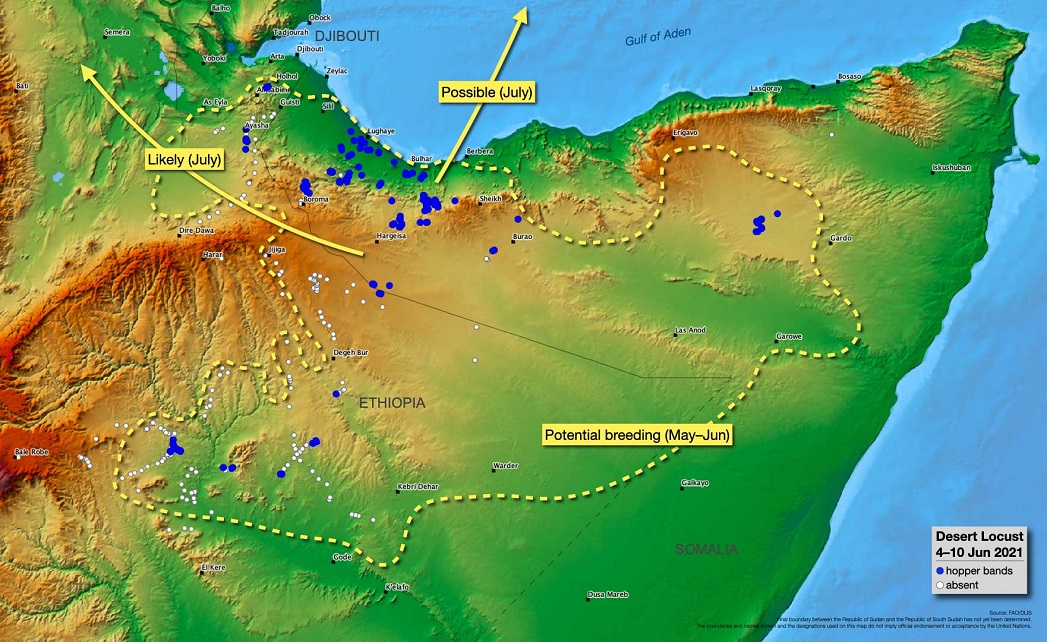
Situation and forecast.
3 June 2021. More hatching and bands form in Ethiopia and Somalia
OVERVIEW. Despite an earlier decline, the current upsurge prevails in the Horn of Africa where good rains allowed breeding to continue with hatching and more hopper bands forming in eastern Ethiopia and northern Somalia.
WHY IT MATTERS. In addition to aerial operations, ground survey and control teams will play an important role in finding and reducing hopper band infestations this month before they fledge and form a new generation of immature swarms starting in late June and continuing into July. The swarms are expected to move to the Afar region in northeast Ethiopia for summer breeding in August and September where above-normal rains are forecasted.
CONTEXT. Locusts remain active in the Horn of Africa but are declining in the Arabian Peninsula.
• SAUDI ARABIA / YEMEN: Hopper bands have declined in the northern interior of Saudi Arabia due to control and drying conditions. Nevertheless, immature adult groups and perhaps a few small swarms could form and move south to the interior of Yemen where only solitarious adults are present but conditions are favourable for breeding.
• NEAR EAST: Control operations were undertaken in parts of Iraq, Jordan, Syria and Lebanon against hoppers that hatched and formed small groups and bands as a result of earlier breeding by adult groups and small swarms that arrived in April.
• SW ASIA: Although control operations continue in southwest Iran against hopper groups, a few small groups of immature adults could form and move east to the Indo/Pakistan border. Although small scale breeding is likely to commence with the onset of the monsoon in July, locust numbers should remain low.
• WEST AFRICA / SUDAN: Once the summer rains begin, small-scale breeding is expected to occur in the Sahel of West Africa and Sudan from July onwards.
TAKE AWAY. Increased ground survey and control operations are required in Ethiopia and Somalia to treat hopper bands and reduce the scale of eventual swarm formation. Teams are already in the Yemen interior to detect any arrivals from Saudi Arabia and subsequent breeding.

Situation and forecast.
27 May 2021. More bands form in Ethiopia and Somalia
OVERVIEW. Ground teams are detecting an increasing number of early instar hopper bands that are forming in eastern Ethiopia and northwest Somalia as more eggs hatch. This will continue until about mid-June as mature swarms are still laying eggs in some places. Ground and aerial control operations are in progress. In Saudi Arabia, control operations continue in the spring breeding areas of the interior where groups of immature adults have formed and are likely to move south to Yemen for eventual breeding in the interior. So far, a few groups have already migrated to within about 100 km of Yemen.
WHY IT MATTERS. A new round of breeding signifies the potential for a further increase in locust numbers in the Horn of Africa. If hopper band infestations are not adequately detected and treated, new smarms could form from late June onwards and move west during July to the Afar region in northeast Ethiopia for summer breeding. Locust numbers could build up in the interior of Yemen that may eventually threaten the Horn of Africa.
CONTEXT. Locusts are currently active in the Horn of Africa and Saudi Arabia.
• In Ethiopia, more hatching and band formation is taking place in eastern Bale zone of Oromia region and the Somali region, mainly in the western zones of Afder, Erer, Fafan, Jarar, and Nogob zones but most likely underway in other woredas and zones. Mature swarms persist south of Djibouti in Siti zone where hatching and band formation are imminent.
• In Somalia, hatching continues and more bands are forming on the escarpment and plateau in the northwest (Somaliland) where mature swarms are still laying eggs; there are unconfirmed reports of mature swarms in the northeast (Puntland).
• In Saudi Arabia, control operations continue against a few early instar hopper bands in the north near Al Jawf, fifth instar hopper bands and fledglings in the east near Jubail, and immature adult groups between Riyadh and Hail. Today, a few immature adult groups appeared in the Asir Mountains in the southwest near Khamis Mushait.
• In Yemen, scattered adults in the interior areas of Shabwah and Hadhramaut.
• In Sudan, locusts declined on the Red Sea coast and only scattered adults persist near Tokar.
• In Iraq, control operations ended against hopper groups in the upper Euphrates Valley near Syria. No new reports from Jordan, Lebanon and Syria.
• In Iran, a few early instar hopper groups remain on the southwest coast near Bushehr.
TAKEAWAY. Increased ground operations are required in Ethiopia and Somalia to treat hopper bands and reduce eventual swarm formation but only after hatching has completely finished, avoiding repeated treatments of the same area.
• Central Region (SERIOUS) – increase survey and control (Ethiopia, Somalia, Saudi Arabia), increase preparedness, survey and possible control (Yemen interior)
• Eastern Region (CALM) – maintain control (Iran)
• Western Region (CALM) – no activities
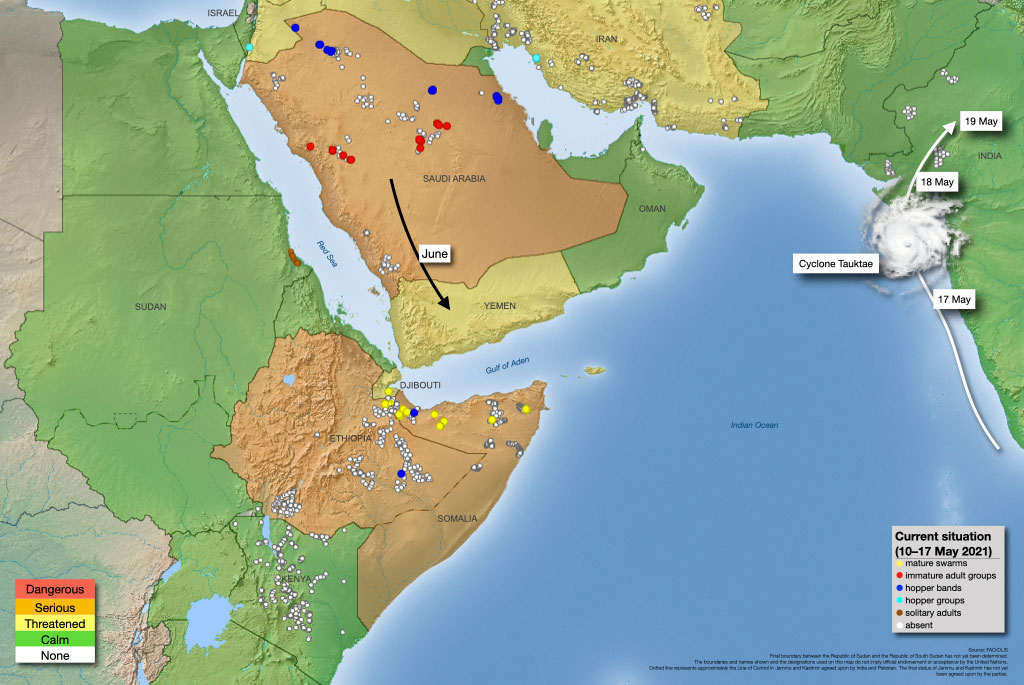
Situation and forecast.
17 May.Hatching and band formation begin in Horn of Africa
OVERVIEW. As anticipated, hatching has been detected in eastern Ethiopia and northwest Somalia where swarms have been laying eggs since late April. The hatchlings are forming small hopper bands that so far have been seen in a few places. More hatching and band formation are expected throughout eastern Ethiopia and northern Somalia during the remainder of this month. New groups of immature adults are forming in Saudi Arabia that could move south to Yemen for breeding in the interior.
WHY IT MATTERS. A new round of breeding signifies the potential for a further increase in locust numbers in the Horn of Africa. If hopper band infestations are not adequately detected and treated, new smarms could form from mid-June onwards and move west to the Afar region in northeast Ethiopia for summer breeding. Locust numbers could build up in the interior of Yemen that may eventually threaten the Horn of Africa.
CONTEXT. Locusts are currently active in the Horn of Africa and Saudi Arabia.
• In Ethiopia, mature swarms are laying eggs south of Djibouti near Aysha. Hatching and band formation are in progress in Nogob zone, western Somali region.
• In Somalia, hatching and band formation have started in the northwest (Somaliland) where mature swarms continue to lay eggs; mature swarms are present in the northeast (Puntland).
• In Djibouti, a mature swarm was seen south of Arta.
• In Saudi Arabia, control operations continue against early instar hopper bands in the north near Al Jawf, late instar hopper bands in the east between Gassim and Jubail, and new groups of immature adults that are forming further south.
• In Sudan, locusts declined on the Red Sea coast where only scattered adults remain near Tokar.
• In Iran, control operations are underway against a few hopper groups on the southwest coast near Bushehr.
• In Israel, hatching occurred on one farm in the Araba Valley near Yahel where migrating birds controlled the first instar hopper groups.
• No new reports from Iraq, Jordan, Lebanon and Syria.
TAKEAWAY. Increased vigilance must be maintained in Ethiopia and Somalia where a hopper band campaign should be mounted to reduce eventual swarm formation but only after hatching has completely finished, avoiding repeated treatments of the same area.
• Central Region (SERIOUS) – increase survey and control (Ethiopia, Somalia, Saudi Arabia), increase preparedness and surveys (Yemen interior)
• Eastern Region (CALM) – maintain control (Iran) and survey (Pakistan)
• Western Region (CALM) – no activities

Situation and forecast.
03 May.Laying in Ethiopia and swarms in the Near East
The upsurge is continuing to decline in the Horn of Africa due to ongoing control operations that treated substantially less in April than the previous month as swarms dwindled. Nevertheless, recent good rainfall has allowed the remaining swarms to mature in Ethiopia where they started to lay eggs in late April that are expected to hatch in early May, giving rise to hopper bands. Similar breeding is likely to take place in northern Somalia while localized breeding could occur in parts of northern Kenya by any remnant infestations. Therefore, intense vigilance should be maintained in the region.
In the Near East, unusually strong southerly winds for several days in April carried groups of mature adults and small swarms north from Saudi Arabia to Iraq, Jordan, Israel, Lebanon and Syria that nearly reached Turkey while others appeared in the Sinai Peninsula. Limited hatching and band formation may occur in a few places during May.
In Saudi Arabia, control operations are in progress in the interior against widespread hatching and hopper band formation. Fledging started in late April and a few groups of immature adults began to form. This is expected to increase during May when small swarms may form that could move south to Yemen, east through the Persian Gulf and, during southerly winds, north to Jordan and Iraq. These countries should be alert.
In southwest Asia, hatching and a few bands formed in southwest Iran where immature adults are likely to form in May and move east towards Pakistan.
The situation remained calm in other regions and no significant developments are expected.

Situation and forecast.
23 April.Desert Locusts spread in Jordan and Syria, appearing in Lebanon
Small groups of mature Desert Locust adults continued to appear in Jordan. While brief periods of southerly winds caused a further spread into western and central areas as well as northwards into western Syria and eastern Lebanon, the groups also moved in several different directions at other times due to variable winds. The infestations are limited in size and number. Small-scale control operations have been carried out in most areas.
In Jordan, more small groups of mature adults were seen on 18–19 April in the southern districts of Amman and near Kerak. On the 21st, similar infestations were mainly concentrated near Azraq but were also reported northeast of Ma’an and in the Jordan Valley.
In eastern Syria, a few small groups of mature adults moved northwest along the Euphrates Valley from Al Bukamal to Deir ez-Zur. In the west, a few small groups of mature adults were seen north of the Jordan border near Suwayda on 18–19 April and then further north near Qarah on the 22nd. Egg-laying was seen on the 23rd in the Qalamun Mountains north of Damascus.
In Lebanon, a few small groups of mature adults crossed the Anti-Lebanon Mountains from Syria into the Bekaa Valley near Aarsal and Ras Baalbek on 22 April. On the following day, a few returned to Syria near Flitah as the winds shifted. Control operations were quickly launched in both areas.
In western Iraq, there was a late report of mature adult groups seen near Rutba two weeks ago on 8 April.
The rare appearance of Desert Locust in these countries is a result of extensive breeding during this past winter along the northern Red Sea coastal plains in Saudi Arabia. In March, adult groups and swarms moved from the coast to the interior of Saudi Arabia where they scattered throughout a large portion of the north and laid eggs that have given rise to hopper bands recently. However, strong southerly winds carried some of the mature adult groups north from Saudi Arabia to Jordan, Iraq and Syria. Although control operations have treated more than 200,000 ha in Saudi Arabia this year, it is common that some infestations escape detection and control because of the vast and remote breeding areas.
A few more small groups of mature adults may arrive in Jordan and Syria, spreading northwards during southerly winds that are expected on 24–25 April. As the adults are already mature, there remains a risk that limited egg-laying will take place in moist sandy areas. If this is the case, hatching can be expected in about two weeks and small hopper groups and bands could form. If so, control teams should wait at least a week to ensure that all hatching is finished before treating in order to avoid spraying the same area more than once.
Elsewhere, widespread rains this past week have caused some of the swarms remaining in Ethiopia and Kenya to mature. Consequently, egg-laying, hatching and band formation are expected in May but at a much smaller scale than last year. Control operations continue.
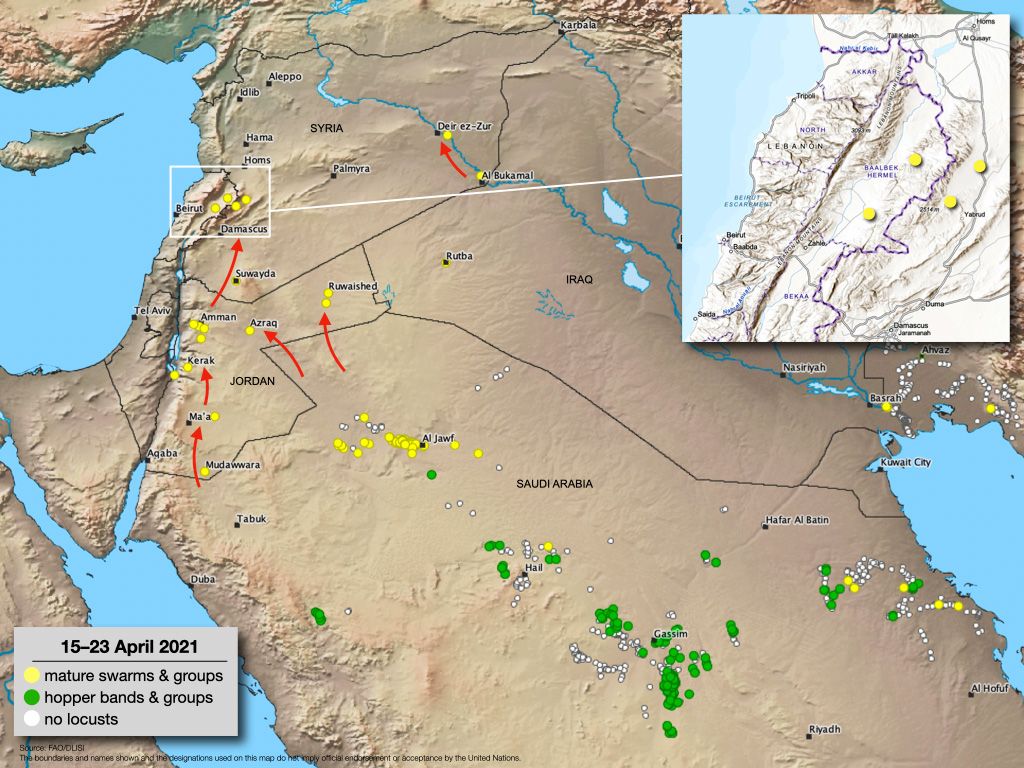
Situation and forecast.
19 April. Desert Locusts appear in Jordan and Syria
A few small mature Desert Locust adult groups and swarmlets appeared in the past few days in Jordan and Syria. The infestations are extremely limited in size and do not represent a large-scale invasion. Small-scale control operations have been carried out in both countries.
In Jordan, a few small groups and swarmlets first began appearing on 14–15 April in the south near Mudawwara and in the east near Ruwaished and the Rawdat Al-Bandan Reserve. Aerial control operations were immediately mounted by the Air Force, treating at least 300 ha.
In Syria, small mature groups arrived in the Euphrates Valley near the Iraq border on 17 April near Ash-Shafah and crossed the river to Al Sayyal in Abu Kamal district of the southeast. The adults settled near crops where local control operations were quickly undertaken.
The rare arrival of Desert Locust in Jordan and Syria are thought to be a single, unusual event caused by several days of strong southerly winds that brought the adult groups and swarmlets from currently infested areas several hundred kilometres to the south in northern Saudi Arabia near Tabuk and Al Jawf. The adults themselves originated from extensive breeding this past winter along the northern Red Sea coastal plains in Saudi Arabia. Although substantial control operations have been carried out by Saudi Arabia, treating more than 200,000 ha this year, it is common that some infestations escape detection and control because the breeding areas are so vast and remote.
While further arrivals are unlikely to occur in Jordan and Syria, there remains a risk that some of the mature adults may have laid eggs. If this is the case, hatching can be expected in about two weeks and small hopper groups and bands could form. If so, control teams should wait at least a week to ensure that all hatching is finished before treating in order to avoid spraying the same area more than once.
Elsewhere, the situation remains unchanged in the Horn of Africa where control operations
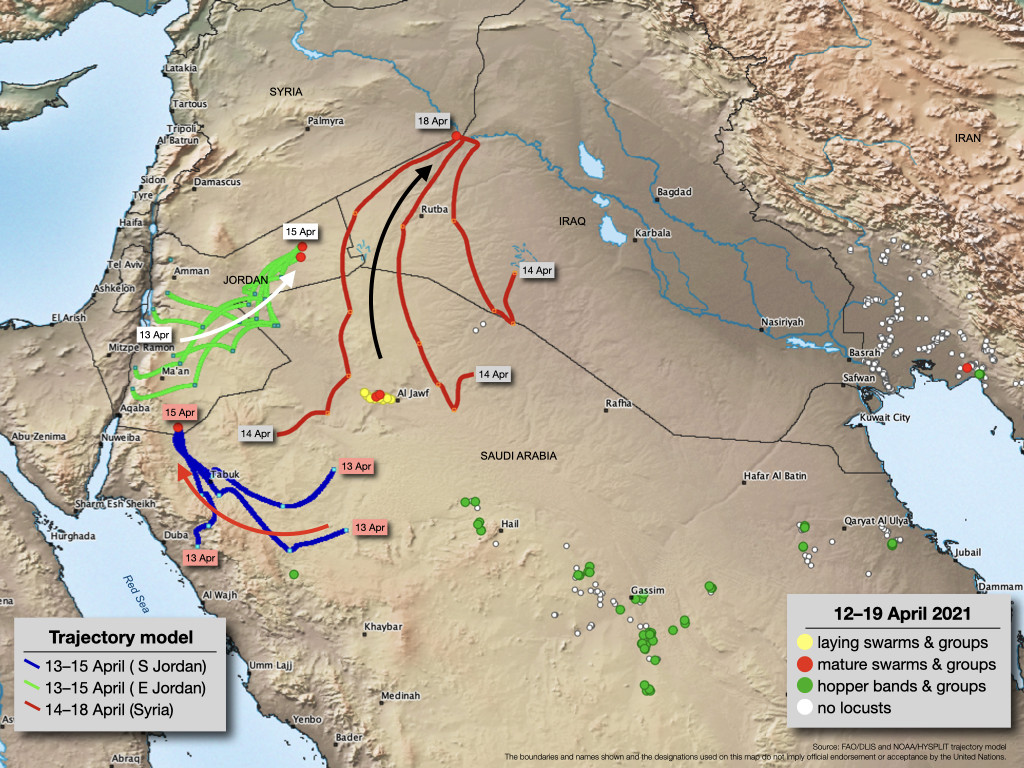
Situation and forecast.
13 April. Upsurge declining in Horn of Africa where rains start
Desert Locust swarms are continuing to decline in Kenya, Ethiopia and Somalia as a result of ongoing control operations. However, good rains have fallen this month in parts of northern Kenya and southern Ethiopia that should allow current swarms to mature and lay eggs. This is likely to give rise to hatching and the formation of hopper bands during May. Compared to one year ago, the scale and extent of the upcoming breeding will be significantly smaller, and the teams, aircraft and other control resources that are currently in place should be able to manage the anticipated breeding.
Even though the situation continues to improve, it is paramount that all countries sustain their current survey and control efforts in reducing existing swarms as well as detecting and controlling any breeding in the coming months. Intense vigilance must be maintained until the autumn.
Currently, the majority of the locust infestations in the region are present in Ethiopia where immature swarms persist to the east of the Rift Valley in the Bale Mountains and Harar Highlands. Both these areas have received rainfall that has runoff towards the eastern lowlands where breeding is expected to occur. Although the situation remains calm further south, a few small swarms may be present in southern Oromia and SNNP.
In Somalia, a few immature swarms were treated in the northeast between Galkayo and Gardo while there have been no recent reports of swarms in the northwest. In Kenya, a few elusive small swarms persist in Samburu county where they are maturing.
The further decline of the current upsurge in the Horn of Africa depends on rainfall and control operations during this spring and summer. If only limited breeding occurs in northern Kenya and southern Ethiopia from now until June, followed by poor rains in northeast Ethiopia during the summer, and assuming that survey and control operations can be maintained, then the situation is likely to return to normal by autumn.
Elsewhere, limited control operations continue against hopper bands on the Red Sea coast in Sudan. Control operations also continue against hopper groups and bands in the interior of Saudi Arabia where more hatching and band formation are expected within a widespread area. In Iran, control operations are underway against a few mature adult groups and swarms in the southwest where breeding is imminent.

Situation and forecast.
3 April. Upsurge begins to decline rapidly
The current upsurge showed signs of significant decline during March as Desert Locust swarms continued to decrease in Kenya, Ethiopia and Somalia due to ongoing control operations and poor rainfall.
Swarms remained immature, waiting for the spring rains that are required for maturation and egg laying. While this may still occur in April, below-normal rainfall expected this spring would limit breeding to parts of northern Kenya and southern Ethiopia at a much lower scale than last year. If this is followed by poor rainfall this summer in northeast Ethiopia, then the Desert Locust situation should return to normal.
Limited breeding occurred in northeast Tanzania from remnants of earlier swarms.
Although winter-bred infestations declined along both side of the Red Sea, late hatching and hopper band formation occurred in Sudan. More importantly, widespread hatching and hopper band formation took place in the interior of Saudi Arabia where control operations combined with earlier than normal dry and hot conditions should be able to reduce these infestations. In addition, strong winds carried a few small mature swarms to Kuwait and southwest Iran. This could lead to hatching and band formation in southwest Iran during April and May.
The situation remained calm in other regions and no significant developments are expected.
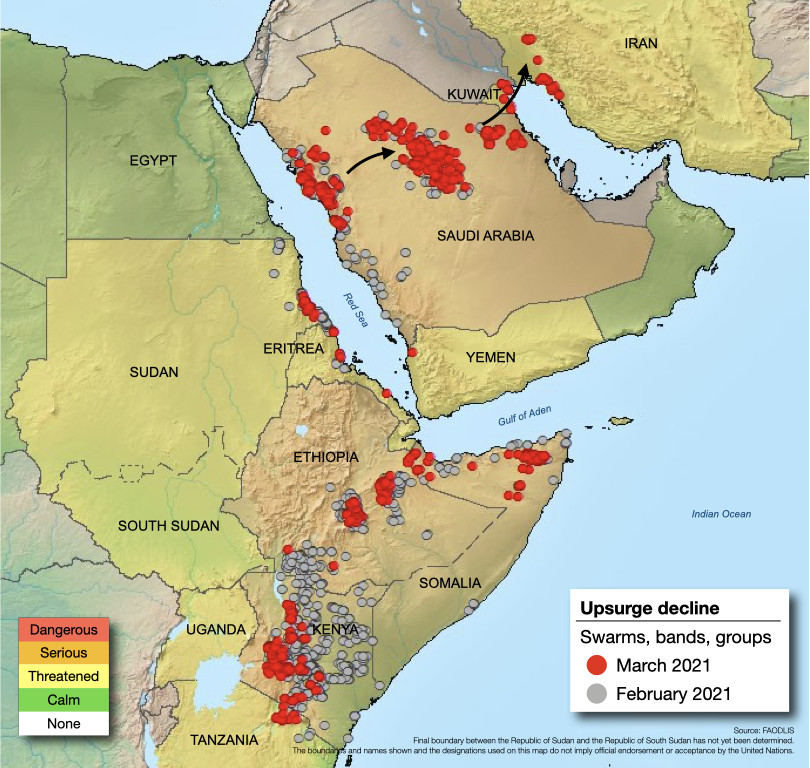
Situation and forecast.
25 March. Swarms continue to decline in Horn of Africa
As a result of poor rains in Kenya and Ethiopia, the swarms currently present in both countries are remaining immature and continue to decline due to ongoing control operations. Without rainfall, the swarms will not mature and breed, thus severely limiting the scale and extent of any breeding this spring. The current situation is likely to continue for the remainder of this month as no significant rains are predicted to fall in northern Kenya, Ethiopia or Somalia.
For this reason, there is cautious optimism that the current upsurge is winding down in the Horn of Africa, especially if poor rains limit breeding this spring in northern Kenya and southern Ethiopia, followed by equally poor rains during the summer in northeast Ethiopia. Nevertheless, it is essential to increase surveys and sustain current control operations in the affected countries as well as maintain a close watch for are any unusual developments.
In Kenya, a few small immature swarms continue to be seen mainly in the Rift Valley of Nakuru county west of Mt. Kenya. There were also occasional swarm reports south of Nairobi in Kajiado county near the Tanzania border and further north in Samburu county. Control operations are in progress, but some could not be treated as they are near communities.
In Ethiopia, control operations continue against a few small immature swarms in the highlands east of the Rift Valley, mainly in Arsi district of Oromia region and, to a lesser extent, further north in East Harerghe district. The situation has calmed down in southern Oromia and SNNP.
In Somalia, control operations are continuing in the northeast (Puntland) against some immature swarms on the plateau northwest of Iskushuban. A few hopper bands persist and at least one swarm was reported to be maturing in the same area. In the northwest (Somaliland), scattered immature adults are present on the plateau between Hargeisa and Burao. Most of the swarms are expected to remain on the northern plateau and perhaps drift west towards Jijiga and Dire Dawa in eastern Ethiopia.
In northern Tanzania, small-scale hatching occurred northwest of Arusha from remnants of mature swarms that laid eggs at the beginning of this month. Ground teams are treating a few small early instar hopper bands that have formed.
In Saudi Arabia, locust infestations declined on the northern Red Sea coast. However, control operations are in progress in the interior against numerous early instar hopper bands from hatching in the spring breeding areas near Gassim.
Elsewhere, the situation remains calm. In Sudan, limited control operations are in progress against early instar hopper bands on the Red Sea coast north of Tokar Delta. Scattered adults are present in a few other places on the coast between Suakin and Karora. In Yemen, a few adults are present on the southern coastal plains.

Situation and forecast.
16 March. Swarms declining in Kenya and Ethiopia
Swarms currently present in Kenya and Ethiopia continue to decline due to ongoing control operations and no breeding. In the absence of rainfall, the swarms have remained immature and are awaiting the start of the rains to mature and breed. So far, these rains have not yet started but showers may occur by the end of this month in some areas that could initiate breeding. Nevertheless, the seasonal predictions continue to call for well-below normal rains this spring, which could severely limit the scale and extent of any upcoming breeding.
In Kenya, a few small immature swarms were seen in the past few days between Mt. Kenya and the Rift Valley in Nyandarua, Nakuru and Baringo counties. In Ethiopia, immature swarms persist in the Ahmar Mountains east of the Rift Valley in Oromia (Bale, Borema, Arsi) between Awasa and Harar, but appear to be declining in southern SNNP (South Omo, Konso). In Somalia, late instar hopper bands are present in the northwest (Somaliland) and the northeast (Puntland) where a limited number of immature swarms continue to form. Other areas in the northeast are likely to contain locusts but cannot be accessed. Swarms that form in the northwest and northeast are expected to disperse along the northern plateau while some could move into adjacent areas of eastern Ethiopia near Jijiga and Dire Dawa.
There is cautious optimism of signs that the current upsurge is winding down in the Horn of Africa, especially if poor rains limit breeding this spring, followed by equally poor rains during the summer in northeast Ethiopia. However, it will be essential to sustain current survey and control operations in Ethiopia, Kenya and Somalia, and maintain vigilance in case there is any unusual rainfall.
The situation remains calm in Yemen where scattered adults are present on the Red Sea and Gulf of Aden coasts. As vegetation dries out further, a few groups and perhaps small swarms could form on the Red Sea coast and move inland across the highlands to the lowland desert between Marib and Wadi Hadhramaut where breeding could occur if rains fall.
In Saudi Arabia, control operations continue on the northern Red Sea coast between Bader and Umm Lajj against hopper bands and immature adult groups as well as in the interior where adult groups are breeding and more hatching is underway between Riyadh and Hail, causing hopper groups and bands to form.
In Sudan, limited breeding continues along the Red Sea coast near Tokar Delta where control operations are in progress against a few hopper bands and groups of hoppers and adults. In Eritrea, a few hopper groups are present on the central coast near Massawa.
The situation remains calm in other regions.

Current situation.
3 March. Immature swarms persist in East Africa
Control operations continue in Ethiopia and Kenya against swarms that are still immature. Good progress has been achieved, particularly in Kenya where swarms are no longer arriving from the north. The swarms that are currently present in northern and central areas are smaller and much less numerous than one year ago. In Ethiopia, immature swarms remain in the south (South Omo, Konso), east of the Rift Valley in the Bale Mountains (Arsi, Borena), and to the northeast in the Harar Highlands (East Harerghe) where swarms were seen arriving from adjacent areas of northwest Somalia in the past few days.
Showers that fell during the last week of February may allow swarms to mature rapidly in northern Kenya and southern Ethiopia and lay eggs that could hatch in late March, causing small hopper bands to form. However, breeding this spring is likely to be limited as control operations continue to reduce current infestations and well below-normal rains are forecasted.
In northeast Tanzania, there have been reports in the past few days of small immature swarms near Arusha in which some of the adults are starting to mature. These may be remnants of swarms that were previously treated.
In northern Somalia, late instar hopper hands are still present in the northeast (Puntland) and on the northwest coast (Somaliland) near Djibouti. New immature swarms continue to form in both areas and aerial control operations are in progress. The swarms are likely to disperse on the northern plateau, possibly reaching eastern Ethiopia near Jijiga and Dire Dawa. No reports of locusts have been received recently from central and southern Somalia.
In the Red Sea winter breeding areas, control operations are in progress against a few swarms on the central coast in Sudan where breeding is continuing. A few adult groups and small swarms could move inland to the Atbara and Nile river valleys. Local breeding is also underway on the central coast of Eritrea while the situation is calm further north near Sudan. In Yemen, low numbers of locusts are present on the Tihama coast.
In Saudi Arabia, control operations continue against hopper groups and bands on the northern Red Sea coast and against mature adult groups that are laying in the vast spring breeding areas of the interior. Early rains combined with unusually warm temperatures allowed ecological conditions to become favourable about one month earlier than normal, which could give rise to widespread hatching and band formation later this month.
The situation remains calm in the other regions.
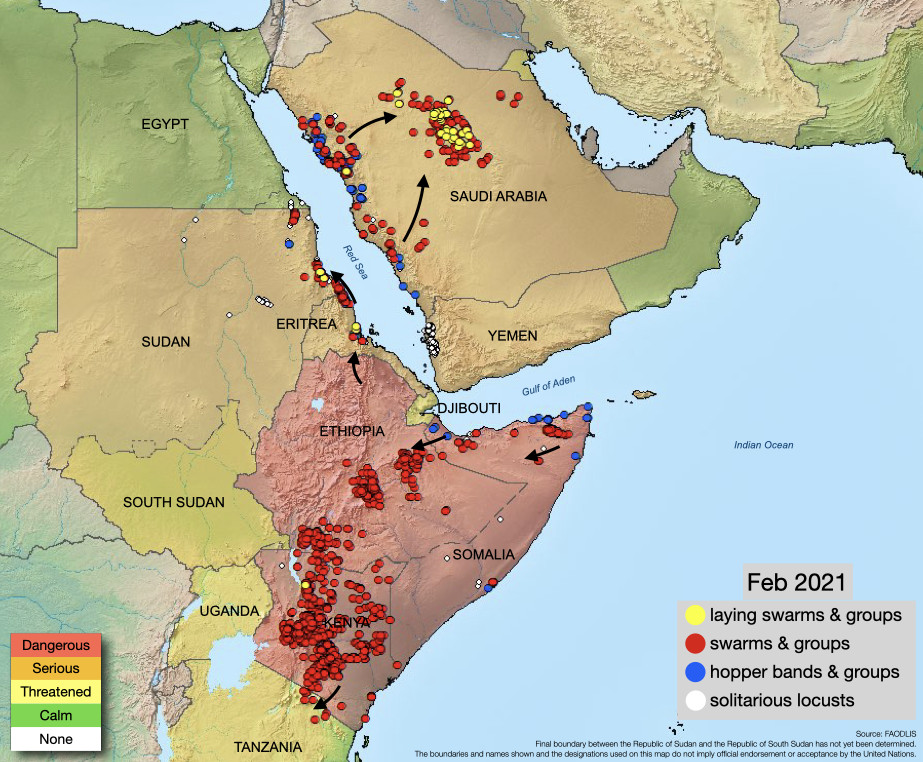
Current situation.
23 February. Good progress made in Kenya & Ethiopia
In the past few days, light to moderate rains fell in northern Kenya and southern Ethiopia that could be sufficient to allow the swarms present in both countries to mature and eventually lay eggs, which would give rise to another generation of breeding. However, the scale of spring breeding is expected to be limited because of ongoing control operations that continue to reduce the number of swarms and the likelihood of poor spring rains starting next month.
In Ethiopia, immature swarms persist in Oromia (East Harerghe, Arsi, Borena) and SNNP (South Omo, Konso) regions, including southern areas of the Rift Valley where more swarms were reported.
In Kenya, small immature swarms are declining in northern and central counties. Many of the highly mobile swarms continue to be reported many times repeatedly, leading to multiple reports of the same swarm. There were no new reports of swarms arriving from Somalia. A few small swarms moved from southern Kenya to northeast Tanzania where they were reported near Mt. Kilimanjaro in Longido district of Arusha region and further south in Manyara region. One aircraft was deployed from Kenya and control operations are underway.
In Somalia, hopper bands and new immature swarms continue to form in the northeast (Puntland). Additional surveys are required in the northwest (Somaliland) where a similar situation is likely to be underway. The swarms that form in northern Somalia are likely to disperse along the northern plateau, drifting west towards Aysha district (Somali region) in eastern Ethiopia. A few swarms may move south towards Kenya.
The present situation in the Horn of Africa differs significantly from one year ago. The current swarms are smaller in size and less numerous. So far, the swarms have not matured or laid eggs. Very little rain has fallen since the end of the short rains last year. Intensive aerial control operations, supported by ground teams, are well-established and making good progress in reducing locust infestations.
A few adult groups and small swarms are forming on the Red Sea coastal plains in Sudan and Eritrea. In Yemen, low numbers of solitarious adults persist along the Red Sea coastal plains. In Saudi Arabia, hopper bands are present and groups of immature adults are forming on the northern Red Sea coast. An increasing number of mature adult groups and a few swarms are laying eggs in the interior between Riyadh and Hail where hatching is expected to start in early March. Although intensive control operations are in progress, a few groups have nearly reached the Persian Gulf and could reach Kuwait and the coastal plains in southwest Iran during periods of south-westerly winds.
The situation remains calm in the other regions.
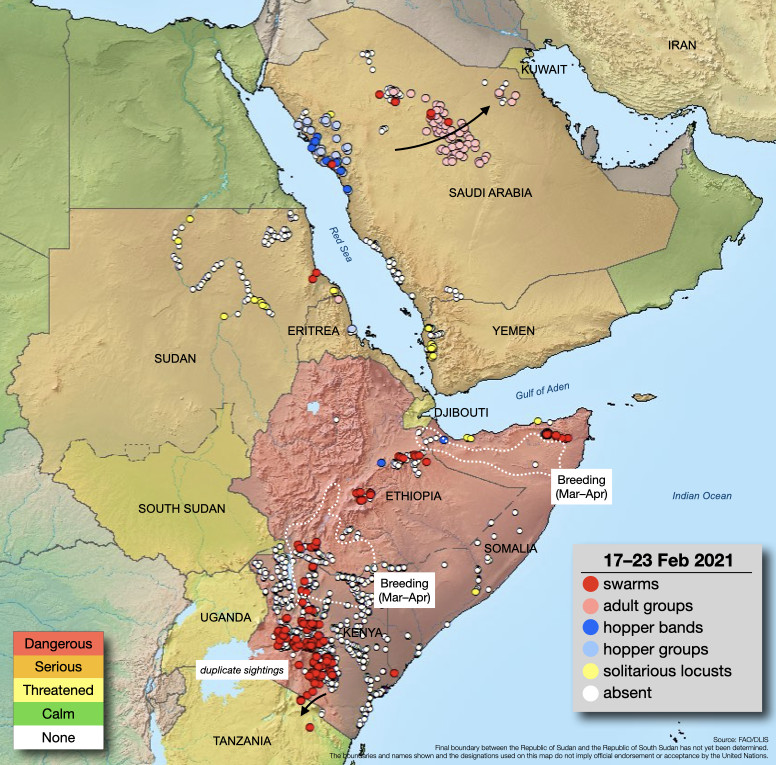
Current situation.
16 February. New swarms form in northern Somalia
In Somalia, new immature swarms continue to slowly form from breeding in the northeast (Puntland) where hopper bands persist near the coast. A similar situation is likely to be in progress along the northwest (Somaliland) coast as at least one immature swarm was seen on the escarpment. More swarms are expected to form this month in both areas and disperse along the northern plateau, drifting west towards Aysha district (Somali region) in eastern Ethiopia.
In Kenya, numerous small immature swarms persist in northern and central counties. While swarms arriving from Ethiopia and Somalia have declined, the highly mobile swarms present in Kenya are often seen many times, leading to multiple reports of the same swarm. Nevertheless, the number of swarms is declining as swarms have been reported during the past few days in 11 counties (Wajir, Marsabit, Samburu, Baringo, Meru, Tharaka-Nithi, Embu, Kitui, Machakos, Makueni, Nyandarua) compared to 15 counties last week.
In Ethiopia, immature swarms persist in Oromia (East Harerghe, Arsi, Bale, Borena) and SNNP (South Omo, Konso, Amaro, Derashi) regions, including southern areas of the Rift Valley.
Intensive ground and aerial control operations continue to make good progress in reducing the number of swarms in Kenya and Ethiopia, especially in the absence of significant rains that are required for maturation and breeding. In this way, spring breeding that is expected to occur from March to June is likely to be on a much-reduced level, considering that the latest precipitation predictions continue to call for unusually dry conditions.
In Yemen, locust numbers remain low along the Red Sea coastal plains where scattered adults are maturing and small-scale breeding may occur in localized areas of recent rainfall.
In Sudan, adults are forming a few small immature swarms on the southern coast of the Red Sea while small adult groups are forming in adjacent areas of Eritrea. In Saudi Arabia, hopper groups and bands are present along the Red Sea coast. Some immature adult groups and swarms have formed and are moving to the interior between Gassim and Hail where at least one group matured and was seen laying. Control operations continue in all three countries.
The situation remains calm in the other regions.

Current situation.
9 February. Swarms persist in Kenya and Ethiopia
In Kenya, immature swarms persist mainly in northern and central counties. In the past five days, swarms have been reported in 15 counties (Madera, Wajir, Garissa, Marsabit, Samburu, Isiolo, Meru, Tharaka, Tana River, Kilifi, Kitui, Machakos, Laikipia, Nakuru, Nyandarua) but as many swarms are highly mobile, the same swarm can easily be sighted several times. There have been no further reports of swarms in Turkana while a few small immature swarms formed from previous breeding along the coast near Lamu and probably in adjacent areas of southern Somalia. The number of swarms arriving from the north continued to decline. While rains have fallen in southern counties, more rain is needed in the north where the swarms are more likely to eventually mature and lay eggs. In order to reduce the next generation of breeding, ground and aerial control operations are focusing on the swarms before they can mature and lay.
A similar situation is underway in Ethiopia where immature swarms persist mainly in southern SNNP (South Omo) and east of the Rift Valley in Oromia (Bale, Borema, Arsi). As little rain has fallen in these areas, most of the swarms are expected to remain immature until more rainfall occurs to allow them to mature and lay eggs. Current ground and aerial control operations are working to reduce these swarms and the scale of the upcoming breeding.
In Somalia, a few new immature swarms have started to form in the past few days from breeding in the northeast (Puntland) where hopper bands are still present. A few residual hopper bands are likely to be on the northwest coast and one immature swarm was seen on the plateau south of Hargeisa, suggesting that new swarms are forming from the coastal breeding. As more swarms form in the north, most are expected to disperse along the northern plateau while some could move into adjacent areas of eastern Ethiopia or move south towards central and southern Somalia.
Mainly dry conditions are expected during the remainder of February in Somalia, northern Kenya, and southern Ethiopia.
In Yemen, scattered adults are maturing along the Red Sea coastal plains where small scale breeding could occur in the few areas that remain favourable. Current infestations are not high enough to warrant control operations. No surveys were conducted recently along the Gulf of Aden plains.
In Saudi Arabia, immature adult groups from local breeding along the Red Sea coast moved through the Asir Mountains to the interior near Riyadh and Gassim. Breeding continues along the coast on both sides of the Sudan / Eritrea border. Control operations continue in all three countries.
The situation remains calm in the other regions.
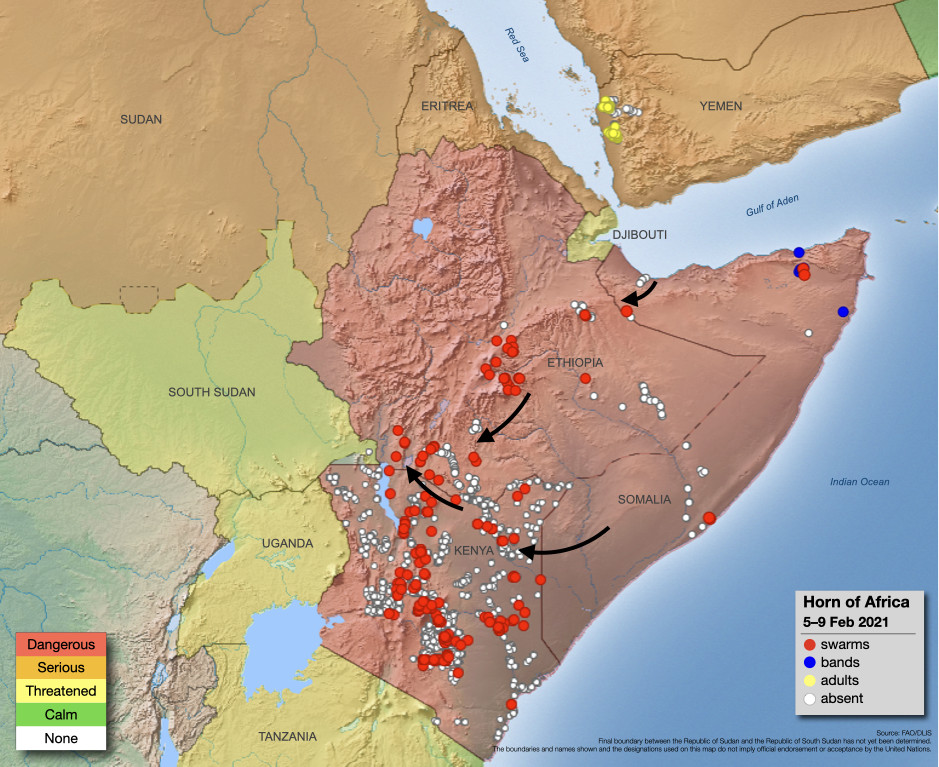
Current situation.
4 February. Swarm invasion declining in Kenya
Numerous immature swarms persist in southern Ethiopia and Kenya. There has been increased swarm movement in Oromia (East Harerge, Bale, Borema, Arsi) and SNNP (South Omo) regions of the south. The few swarms that moved to northern Ethiopia (Afar and Amhara) continued to Eritrea and reached the Red Sea coast where they were controlled. In Kenya, immature swarms continue to spread westwards across northern and central counties where there are currently about 20 small swarms present, mostly about 50 ha in size. Some of the swarms are in community areas and therefore cannot be treated. A small swarm reached Keiyo-Marakwet county in the west and another one was reported today in Turkana county in the northwest; hence, there is a risk that a few swarms could reach eastern Uganda and southeastern South Sudan.
It appears that the peak of the Kenya invasion has now passed as there have been no new reports of incoming swarms in the past two days and no further swarm reports in the east (Wajir, Garissa). Intensive control operations are underway in Kenya and southern Ethiopia to reduce the potential scale of the next generation of breeding. If rains fall in the next week or so, the swarms will quickly mature and lay eggs that will hatch and cause hopper bands to form; otherwise, this will be delayed until the arrival of the seasonal rains in March.
In Somalia, hopper bands are present on the northwest coast and in the northeast where some have started to fledge and will be forming immature swarms. Intensive control operations are underway to reduce the number of new swarms that will form this month. Swarms that form on the northwest coast are likely to move to the plateau and adjacent areas of eastern Ethiopia while swarms in the northeast are expected to spread west along the plateau where they could mature and give rise to another generation of breeding from about mid-March onwards, especially if more rains fall. A few swarms could migrate from the northeast towards southern Somalia where crop damage has been reported from previous swarms.
Control operations continue in winter breeding areas along the Red Sea, mainly against hopper groups and bands that formed along the coast of Saudi Arabia and to a lesser extent against hopper bands on both sides of the Eritrea/Sudan border. Any infestations that escape control in Saudi Arabia could form adult groups and swarms that would most likely move inland to the spring breeding areas of the interior. In Yemen, scattered adults persist mainly along the Red Sea coast and to a lesser extent on the Gulf of Aden coast in the south. There remains a risk that a few swarms may be present in inaccessible areas of the north, which could move to adjacent areas of southwest Saudi Arabia.
The situation remains calm in the other regions.
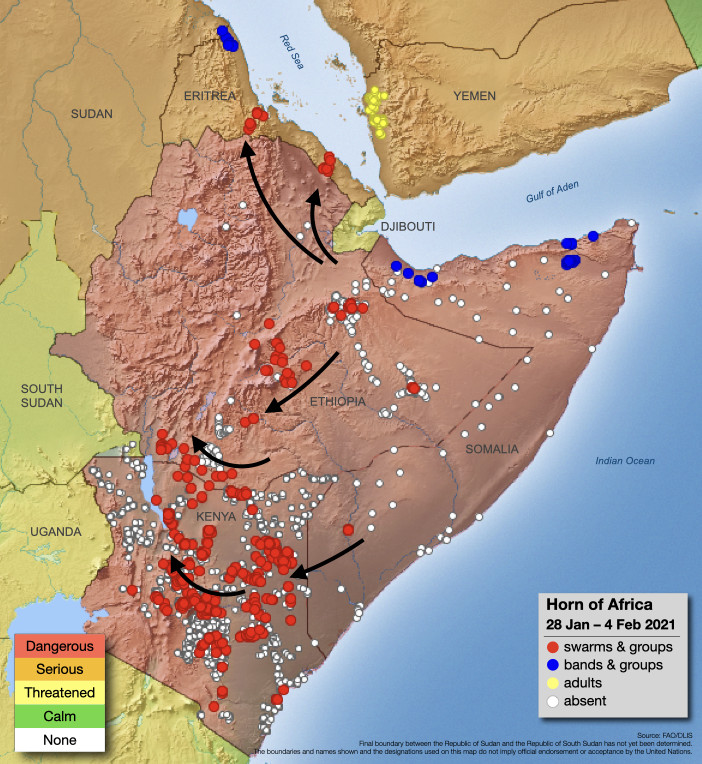
Current situation.
26 January. Swarms appear in SW Saudi Arabia from Yemen
Several immature swarms arrived on the Red Sea coast and Asir Mountains in southwest Saudi Arabia during the past week. These swarms are likely to have originated from adjacent coastal and highland areas in northern Yemen that cannot be accessed safely. Substantial control operations are in progress against early and mid-instar hopper groups and bands on the Red Sea coast in Saudi Arabia from Jizan to Al Wajh. In Yemen, scattered adults are present on the Red Sea and Gulf of Aden coasts that have not required control so far.
In the Horn of Africa, immature swarms continue to arrive and disperse throughout northern and central Kenya. In the past two days, swarms have been reported in 10 counties (Wajir, Garissa, Tana River, Isiolo, Marsabit, Samburu, Laikipia, Meru North, Meru Central, and Tharaka). So far, only a few swarms have started to mature. In the southeast, fledging occurred near Taita Taveta and a few late instar hopper bands were present along the coast.
In Ethiopia, immature swarms have moved into Afar and eastern Amhara regions while other immature swarms continue to be present and are spreading out in parts of Oromia and SNPP regions. Immature swarms persist south of Jijiga and a few remain in parts of the eastern Somali region where it is drying out. There is a risk that a few swarms could continue to move from Afar into Amhara and Tigray and perhaps reach the Red Sea coast of Eritrea and Saudi Arabia. Swarms will mature shortly and start laying eggs mainly in Oromia and SNNP.
In Somalia, hopper groups and bands are present on the northwest coast and in the northeast where laying is still ongoing. Some swarms have remained in central areas (Mudug, Galgaduud) where they are mature and may breed in any favourable places. Immature swarms are present in the south where they continue to move to Kenya.
As conditions remain dry in some parts of southern and northern Ethiopia and north-central Kenya, the swarms are likely to spread out looking for favourable areas to mature and lay eggs if rains fall in the coming weeks. This would give rise to hopper bands during February and March. Intense aerial and ground control operations are in progress to reduce the current swarms so that the scale of the upcoming breeding may be lower.
Breeding continues along the Red Sea coastal plains on both sides of the Eritrea/Sudan border where control teams are treating hopper groups and bands. Similar breeding is in progress in Wadi Diib in northeast Sudan.

Current situation.
22 January. Swarms appear in NE Ethiopia
In the past few days, there have been new reports from northeast Ethiopia of swarms in Afambo, Asayita and Dubti districts of the Afar region as well as in North and South Wollo zones in eastern Amhara region. The swarms are likely to have arrived from the Sitti zone near Dire Dawa and northwest Somalia. There is a risk that the swarms could continue to move further into Amhara and reach the Tigray region. Elsewhere, immature swarms are present in Oromia and SNPP regions.
In Kenya, several immature swarms continue to arrive from the north, mainly appearing in the northeast and east, from where they are spreading west into northern and central counties. Swarms have now been reported in 11 counties (Mandera, Wajir, Garissa, Marsabit, Turkana, Samburu, Laikipia, Isiolo, Meru North, Meru Central, and Tharaka) compared to seven at the beginning of this week. So far, only a few swarms have started to mature. In the southeast, fledging is in progress near Taita Taveta, causing small immature swarms to form while a few late instar hopper bands are present along the coast.
As conditions remain dry in some areas, the swarms are expected to disperse throughout southern and northern Ethiopia and north-central Kenya. Any rainfall that occurs in the coming weeks while cause swarms to mature and lay eggs that will hatch and give rise to hopper bands during February and March.
Intense ground and aerial control operations are in progress in both countries to reduce current swarm populations so that the scale of the upcoming breeding may be lower.

Current situation.
18 January. Swarms continue to invade Kenya
In the Horn of Africa, aerial and ground control operations continue against highly mobile swarms in Ethiopia and Kenya, and hopper bands and mature swarms in northern Somalia.
In Ethiopia, immature swarms that were previously concentrated along the eastern side of the Harar Highlands in Oromia region have now spread throughout the region to the east of the Rift Valley. Immature swarms are also moving northwards along the Rift Valley in SNNP region. Other swarms remain concentrated between Harar, Jijiga, and Dire Dawa where at least one swarm was reported copulating. Additional swarms are likely to appear in the Rift Valley south of Adama. The swarms will mature and lay eggs once rains fall.
In Somalia, breeding continues in the northwest and northeast where mature swarms and hopper bands are present in areas that received good rains from cyclone Gati in late November. Immature swarms continue to move south of the Shebelle River towards Kenya.
In Kenya, several immature swarms are arriving every day and spreading west throughout northern and central areas. Swarms have now been seen in seven counties (Wajir, Garissa, Marsabit, Samburu, Laikipia, Isiolo, Meru North) compared to four last week. A few swarms are starting to mature. In the southeast, hopper bands are present near Taita Taveta and on the coast that could form swarms shortly.
As conditions remain dry in some areas, the swarms are expected to disperse throughout southern Ethiopia and north-central Kenya. Any rainfall that occurs in the coming weeks while cause swarms to mature and lay eggs that will hatch and give rise to hopper bands during February and March.
Winter breeding continues along both sides of the Red Sea. In Yemen, maturing swarms appeared in the highlands west of Sana’a most likely coming from inaccessible areas on the coast and elsewhere. Scattered adults are present along the Red Sea and Gulf of Aden coastal plains but do not require control. In Saudi Arabia, control operations are in progress against mainly second instar hopper groups and a few bands along the coast from Jizan to Lith, extending nearly to Duba on the north coast. In Sudan, control teams are treating hopper bands along the Atbara River, on the coast near Eritrea and, mixed with groups of adults, along Wadi Oko/Diib in the northeast near Egypt. In Eritrea, hopper groups and bands are being treated on the northern coast.
All countries should maintain maximum efforts in conducting the necessary survey and control operations to reduce further migration and breeding.

Current situation.
11 January. Swarms continue to invade Kenya
In the Horn of Africa, immature swarms continue to migrate southwards from breeding areas in eastern Ethiopia and central Somalia to southern Ethiopia and northern Kenya. There were reports that a few immature swarms reached Mwanga district in northeast Tanzania on 8 January 2021.
In Ethiopia, immature swarms are concentrating along the eastern side of the Harar Highlands in Oromia region as they move to southern areas of the country, including southern parts of the Rift Valley in SNNP region. There are also cross-border movements near Jijiga and northwest Somalia and along the southern border with Kenya.
In Kenya, immature swarms continue to arrive and spread throughout the north. So far, swarms are present in four counties (Wajir, Garissa, Marsabit and, most recently, Isiolo). Breeding continues, and hopper bands are present in the southeast near Taita Taveta and along the coast.
In Somalia, mature swarms are present in the northwest and breeding is in progress on the coast where hopper bands have formed. Breeding also continues in the northeast where numerous hopper bands are concentrated between Iskushuban and Bosaso. Breeding may also be underway in other areas on the northern plateau that received heavy rains from cyclone Gati. Immature swarms continue to move southwards in central and southern regions towards Kenya.
Control operations continue in all affected countries.
As conditions are dry in some areas where the swarms are arriving, they are expected to disperse throughout southern Ethiopia and northern Kenya. There is a moderate risk that a few swarms could reach central Kenya and perhaps the southwest as well as northeast Tanzania, eastern Uganda, and southeast South Sudan during January. Once swarms arrive in favourable areas, they will mature and lay eggs that will hatch and cause hopper bands to form during February and March.
Elsewhere, breeding is underway along both sides of the Red Sea coast. Hopper groups and bands are present along both sides of the Sudan/Eritrea border. Scattered solitarious adults prevail along the Red Sea and Gulf of Aden coastal plains in Yemen, and one mature swarm appeared in the northern highlands from the coast.
All countries should maintain maximum efforts in conducting the necessary survey and control operations to reduce migration and breeding.
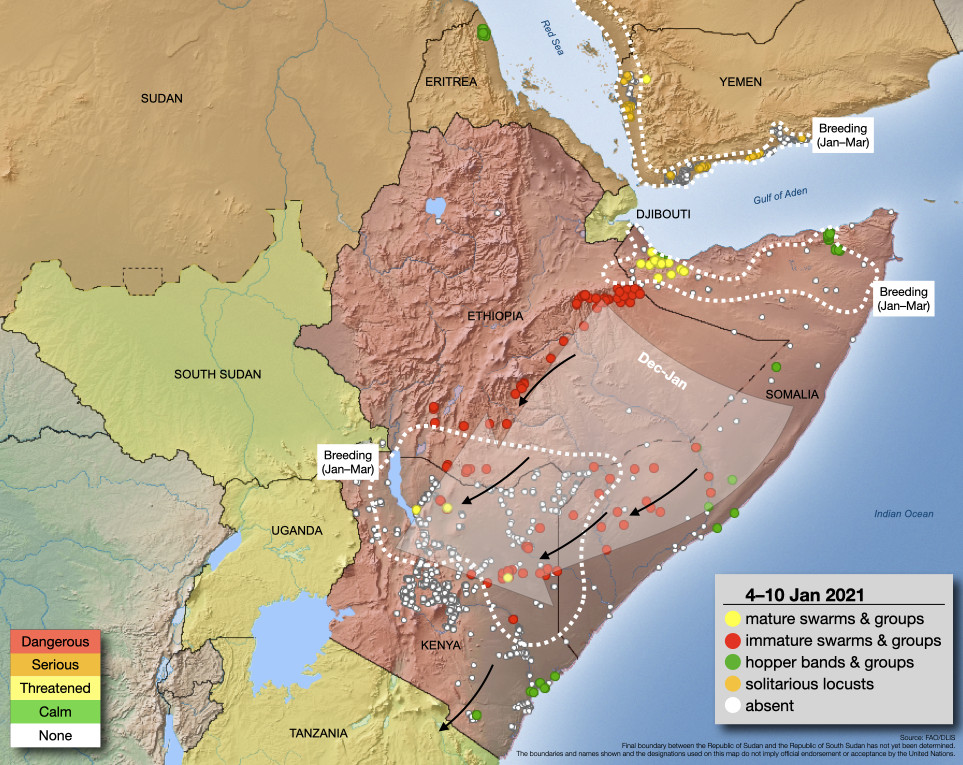
Current situation.
4 January. Invasion of southern Ethiopia and Kenya to continue
Numerous immature swarms formed in eastern Ethiopia and central Somalia during December, which moved to southern Ethiopia, reaching northern Kenya on 21 December. More swarms will arrive during January and spread throughout southern Ethiopia and northern, central, and eastern counties of Kenya where they will mature and lay eggs that will hatch and give rise to hopper bands from late January onwards.
In northern Somalia, swarms laid eggs in areas affected by Cyclone Gati where hatching is underway and causing numerous early instar hopper bands to form. Hatching will continue until about mid-January. New immature swarms could start to form in early February.
In Saudi Arabia, swarms that appeared during December on the Red Sea coast, perhaps from Yemen, laid eggs that are hatching and causing numerous hopper bands to form. Some swarms also reached interior areas where they will slowly mature and breed once temperatures warm up.
Adult groups and a few swarms appeared on the coast of Sudan and Eritrea in December. Breeding is continuing, albeit on a smaller scale than Saudi Arabia, which will cause further hatching that will cause hopper groups and bands to form.
In Yemen, control has not been required so far because locusts are solitarious and scattered along the Red Sea and Gulf of Aden coasts. However, breeding will cause locusts to increase, leading to a new generation of hopper groups and bands that will require control from about late January onwards.
In the Western Region, locusts that concentrated and formed small groups were treated in Mauritania, Niger, and Algeria during December.
In southwest Asia, adult groups in southwest Iran will eventually breed once temperatures warm up.
During December, aerial and ground control operations treated more than 336 000 ha. Nevertheless, intensive monitoring and control efforts will need to be maintained and extended to all breeding areas.

Current situation.




